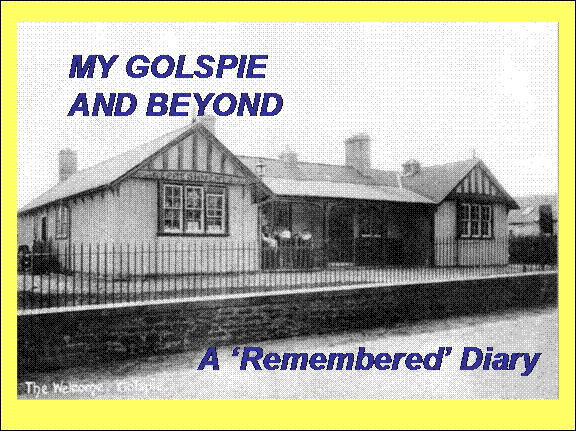
| A 'Remembered' Diary |

The Lannons
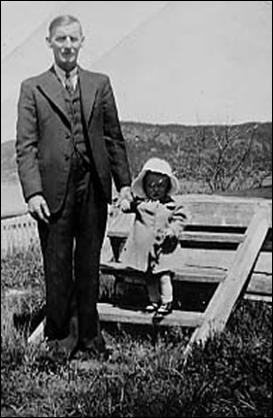
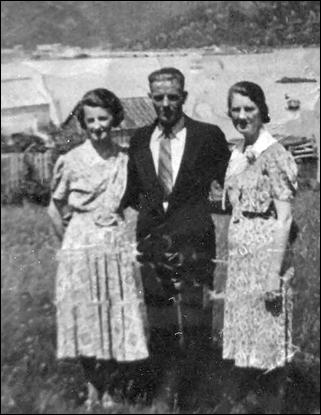
My father came to
The left picture shows grandfather John Lannon with one of the
grandchildren and the picture on the right is my father, Matthew,
with his sisters Annie (left) and Mary in 1940 just before he left
for
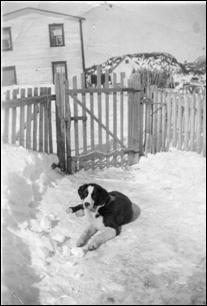
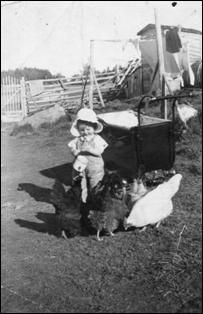
The picture on the left is
of the home of my father’s Uncle Matt and is in
Life at Culmaily
Grandfather George
Melville was a ploughman at Culmaily Farm and the family lived
in part of the small cottage at the turn on the A9 between
Drumuie and Culmaily just opposite Gilander’s smiddy and the
spring below the house on the right hand side going south.
The low single , story building is now one property but in the
1920s and 1930s it housed three families. The Melvilles were in
the end to the south. They had a livingroom/kitchen and
the ‘master’ bedroom downstairs and in what was effectively the
attic area there was a family bedroom. It stretch over the
downstairs area and over at least part of the middle of the
property making the house a little larger than the middle one
though maybe about the same size as the other end abode of the
third family. All the Melville children had to sleep in
this upper area and though there were nine of them never that
many had to find space. Some of my mother’s older siblings
were away to work before she was born there being about 24 years
between the oldest one and herself.
Grandfather George Melville in his WW 1 Seaforth Highlands uniform.
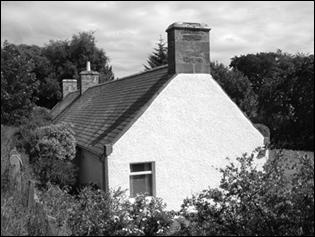
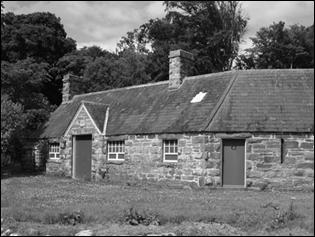
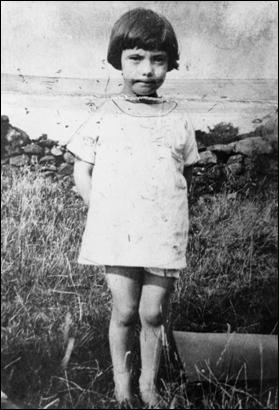
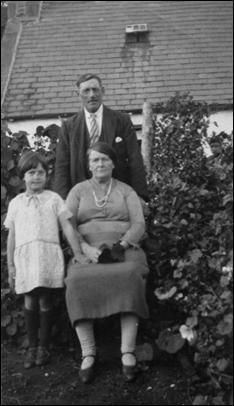
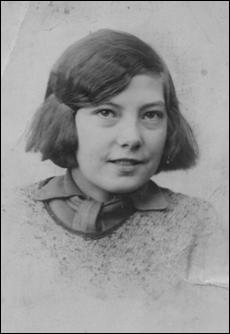
Top left; The Melville
family house at Culmaily. The end shown is the end the
Melvilles inhabited.
Above; Annie Melville around her
early teenage years.
My mother often spoke about life at Culmaily and it did seem as
though she had fun and enjoyed it there. There were
many visitors to the farm cottage as members of this large
family invariably arrived with many friends. The area
of hillside to the south east of Ben Bhraggie was a very
suitable playground for a young family and my other often spoke
of Precepts Green, a flatter area behind the smiddy and to the
east of Drummuie Farm. I am not sure of the derivation of the
name but it does sound as it was an area of land associated with
the church.
Soldiers were billeted in the house in
At some time during the War my mother volunteered
for the WRENS and was posted to
The Melville Family
The
early information I have about my Uncles and Aunts, other
than the later family research I carried out involving dates
and events, is mostly from my mother. It is recorded as
part of this remembered diary because I think I should make
note of it even though it is very scant and open to error. Hopefully small
error of a general nature but I am always happy to be
corrected. Much
of the information I collected later is in other areas of my
family history record and not for repeating here.
Grandfather
George’s earlier years are not well documented but it is
fairly certain that he took employment on the land from an
early age in the Doll.
He certainly worked at Inverbrora Farm and was
resident and working there when he married Annie Ross on
21st July 1898 in
Though
this first child was legitimised by a hurried marriage he
did, in fact, already have a son to an Annie Murray at
Ladiesloch . This
son was called George, presumably after the father, was born
on 23rd July 1897 and died unmarried in
George
and Annie had their first born at the Doll and probably in
the house in which he was born. Indeed the first
three children Alexandrina, David George and Christina
Fraser, were all born in the Doll. The next five children,
Janettus, John Fraser, William Fraser, Cecil Alexander and
Cathel Sutherland, were born in Murray Buildings, Golspie. This residence was
just off
Sometime
after his marriage and possibly at about the time of his
move to Murray Buildings, Golspie George started work for
Morrison’s the bakers.
He delivered bread and other goods for the business
by horse and cart. This
business survived in Golspie until its demise in 1995.
George’s
employment did not last long at Morrison's. He returned to
his agricultural employment until with the intervention of
the First World War and having 10 years experience with the
1st Sutherland Rifle Volunteers from 1898 to 1908 he
volunteered for duty initially joining the 2/5th Battalion
Seaforth Highlanders. His
date of joining was 27th January 1915 and George's British
Army Pension Record, in addition to his Army record,
indicates that before joining the Seaforths he was indeed a
member of the 1st Sutherland Volunteers for 10 years. An
further entry on the record indicates that he had already
resigned from the Volunteers after his 10 years of service
so his move to full time solider was not consecutive with
his local service.
George's
full time defence role was relatively short lived. It seems he was
for a time prior to September 1916 at Saffron Waldon as his
discharge from the army makes reference to him suffering
from Disordered Action of the Heart which originated there
around April 1916. It was on 25 September 1916 that he was
sent to Guildford Barracks,
Family tradition had
suggested that George had been a Military Policeman during
his Army service. David Bews, Thurso, an expert on matters
military states that the Military Police as such did not
exist at that time. What
did exist was the Military Foot Police under the Provost
Marshal. It may
have been that someone saw he was in the 3rd Prov Bn and
assumed that it was the 3rd Provost Battalion i.e. Police.
An alternative possibility is that he was used guarding Home
(UK) installations and also used as escorting prisoners,
deserters and even wounded to and from locations. In most
cases it was the ordinary army soldier and not the MFP who
were sent to escorts and those and those came from home
battalions like the Provisional Battalions.
The
early information I have about my Uncles and Aunts, other
than the later family research I carried out involving dates
and events, is mostly from my mother. It is recorded as
part of this remembered diary because I think I should make
note of it even though it is very scant and open to error. Hopefully small
error of a general nature but I am always happy to be
corrected. Much
of the information I collected later is in other areas of my
family history record and not for repeating here.
Grandfather
George’s earlier years are not well documented but it is
fairly certain that he took employment on the land from an
early age in the Doll.
He certainly worked at Inverbrora Farm and was
resident and working there when he married Annie Ross on
21st July 1898 in
Though
this first child was legitimised by a hurried marriage he
did, in fact, already have a son to an Annie Murray at
Ladiesloch . This
son was called George, presumably after the father, was born
on 23rd July 1897 and died unmarried in
George
and Annie had their first born at the Doll and probably in
the house in which he was born. Indeed the first
three children Alexandrina, David George and Christina
Fraser, were all born in the Doll. The next five children,
Janettus, John Fraser, William Fraser, Cecil Alexander and
Cathel Sutherland, were born in Murray Buildings, Golspie. This residence was
just off
Sometime
after his marriage and possibly at about the time of his
move to Murray Buildings, Golspie George started work for
Morrison’s the bakers.
He delivered bread and other goods for the business
by horse and cart. This
business survived in Golspie until its demise in 1995.
George’s
employment did not last long at Morrison's. He returned to
his agricultural employment until with the intervention of
the First World War and having 10 years experience with the
1st Sutherland Rifle Volunteers from 1898 to 1908 he
volunteered for duty initially joining the 2/5th Battalion
Seaforth Highlanders. His
date of joining was 27th January 1915 and George's British
Army Pension Record, in addition to his Army record,
indicates that before joining the Seaforths he was indeed a
member of the 1st Sutherland Volunteers for 10 years. An
further entry on the record indicates that he had already
resigned from the Volunteers after his 10 years of service
so his move to full time solider was not consecutive with
his local service.
George's
full time defence role was relatively short lived. It seems he was
for a time prior to September 1916 at Saffron Waldon as his
discharge from the army makes reference to him suffering
from Disordered Action of the Heart which originated there
around April 1916. It was on 25 September 1916 that he was
sent to Guildford Barracks,
Family tradition had suggested that George
had been a Military Policeman during his Army service. David
Bews, Thurso, an expert on matters military states that the
Military Police as such did not exist at that time. What did exist was
the Military Foot Police under the Provost Marshal. It may have been
that someone saw he was in the 3rd Prov Bn and assumed that
it was the 3rd Provost Battalion i.e. Police. An alternative
possibility is that he was used guarding Home (UK)
installations and also used as escorting prisoners,
deserters and even wounded to and from locations. In most
cases it was the ordinary army soldier and not the MFP who
were sent to escorts and those and those came from home
battalions like the Provisional Battalions.
Upon
his return to Sutherland George took up the employment on
the land. He worked at Culmaily Farm firstly as a farm
servant and then as a ploughman. It would appear to
be at this time that the family moved from Murray Buildings
to the farm cottage at Culmaily. This cottage was,
as noted earlier, one of a block of three situated at the
turn in the A9 trunk road just to the south of Drummuie
Farm. The
building is still there but now instead of housing three
large families it is a single summer home for a visiting
family.
George
Melville was ploughman at Culmaily for 21 years but in 1939
he had to give up work there due to illness. He had suffered a
burst ulcer while at work in the fields. He was taken to
the
In
the picture above and the group one below George is shown
carrying cane and in the lower photograph dressed in
trousers and having a braided cord from his shoulder to a
pocket. Army
expert David Bews explains those items of uniform and it is
best to present the information as received from him.
'In the
group photo he is not wearing a kilt. It was usual for those
not going to the front line ie 1st Bn, to wear trousers. The
braid around his shoulder is probably tied of to a whistle
or knife.
What he
has in the two photos is a “walking out stick” also known as
a “swagger stick”. These go back centuries and the reasons
for their introductions are varied. The official reason
(British Army and Marines) are…
When
leaving Barracks that all soldiers would carry a swagger
stick which prevented the soldiers from putting their hands
in their pockets when off duty. The problem with this is, a)
they had two hands and only one stick, b) that back before
the kakhi uniforms they did not have front pockets in their
uniforms and lastly, c) when carrying the stick in the right
arm it prevented a soldier from saluting an officer.
The
main reason they carried them stemmed from being posted to
George’s
wife, Annie, died at Golspie on 14th January 1944. She was ill for a
time and their daughter, my mother, Annie Isabella, returned
from the WRENS in
My
first journey south of Inverness, in the early 1950s was to
Aunts
Chrissie and Alex were very fond of
The
Dalry
was a very different accommodation. A rather dingy flat
in an equally unattractive vicinity though with the area now
cleared and new housing built the effect is quite different. I remember the less
than impressive entrance to the block with its drab walls and
shabby appearance. The flats were built round balconies or
galleries on an open central area. The flat inside was
little better and though obviously kept clean and tidy by my
Aunt the walls had the yellow coating of nicotine produced by
years of smoking by my Aunt Alex and husband Charlie. I say husband
though, in fact, no marriage has ever been found for the
couple. Were they
unmarried or was there a simple error made in not having their
marriage recorded? - there is not much more searching that can
be done so we may never know!
The
The
oldest son, David George commonly known as George and often by
the bye-name Wordie, served his time as a mason with Moore the
builder in Golspie. In
the mid to late 1930s he joined the company of Wordies, from
whence he got his nickname, and drove their delivery horse and
cart taking goods to shops in the Golspie area. He later joined the
railway and worked at Golspie and Brora stations. One job he had was
to go by bike, possible moped or scooter, to the
George
married Jessie Sutherland and had a family of six. They occupied
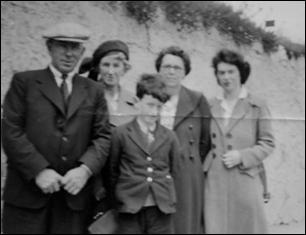
Son Don
worked with the Sutherland and Highland Councils and
resided in
Janettus,
fourth child and second son, generally known to all as Neddy,
worked at Dunrobin Farm having first tried his hand at mental
nursing. He went south with his sisters who thought that
such a career would suit him. However, he was not happy
and the strain of working with disturbed patients of about his
own age upset him. He returned to Golspie to take up work
as a mason firstly with
Though Neddy was well known and respected in the construction
world it is through his work with the voluntary fire service
that he is best known. He was firemaster in Golspie for
many years and very much involved in the community work carried
out by the local fire service. The parties for young and
old started in the early fifties at his time with the service
still provide an excellent Christmas outing for young children
and senior citizens. Though they may not be as socially
necessary now as they were in the early days, when such
occasions were few and far between, they are nevertheless
appreciated by the community.
Neddy was sent for by neighbours when their chimneys went on
fire. He was on hand to give advice and decide whether or not
the whole brigade should be called. My mother was always
worried about a chimney fire and I can only recall it happening
once. The fire burnt fiercely and I had to run for
Neddy. The chimney breast cracked and the noise upstairs
was very loud. However, Neddy was of the opinion that in time
the flames would die down without further action. They did
but not before a period of great anxiety.
Neddy married Mary Sutherland but had no family. He resided at
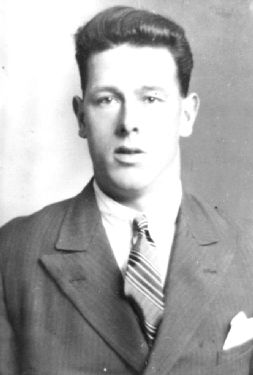
John
Fraser Melville, the fifth child, married Lucy Alexander in
Visits
to the Mound, by bus and occasionally by train, were a
highlight. The wooded area was excellent for all sorts of
games and there was complete freedom to play from the shores of
the Fleet to the lower slopes of the Mound Rock. Trains
were few and far between and road traffic very light.
There were two butchers in the family, William Fraser Melville
and Cathel Sutherland Melville. William worked as a
butcher for Cameron of Kirkton, Grants of Dornoch and Ardgay
Butchers. He lived in Dornoch with his wife, Nellie, and brought
up four children. Cathel the, second youngest, also worked
for Cameron, Kirkton. He married Joey Angus from
Castletown,
Cecil Alexander was the last of the family to marry and leave
the family home. He wed Jessie Alexander in 1949 and lived
in Golspie at various addresses. The Neuk, behind houses on
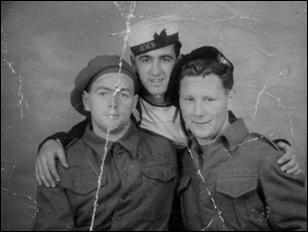
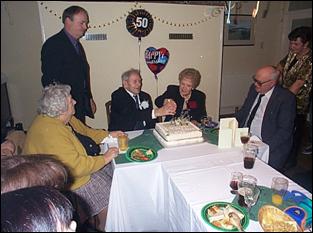
Cecil with Willie Murray and Patty Thomson in
My mother, Annie Isabella Fraser Melville,
was, of course, my mother. As with Cathel there is
sufficient information on a Biography Page about. However,
below I do reproduce her school group photograph in which she is
surrounded by many of her lifelong friends.
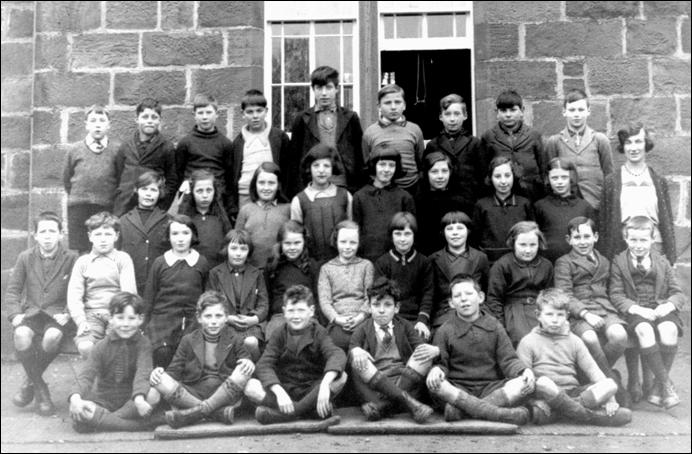
Back Row left to right;
Jim Fraser, Jim Lyon,
John Mackay, John Urquhart, ? , John Trussler,
Hector Macdonald, Berty Harper, Billy Ewen.
2nd Back Row left to
right;
Ninie Dunnett, Ella
Mackay, Jessie Miller, Annie Forsyth, Barbara Duff, Annie
Melville, Margaret Macdonald, Daisy Mackenzie.
3rd Back Row left to
right;
Donald Mackay, Charles
Fraser, Isobel Mackay, Esther Smityh, Betty Sutherland, Dolly
Wilson (?), Mona Mackay, Dorothy Bannerman, Kenny Campbell,
Sandy Mackay.
Front Row left to right;
Patty Thomson, Ernie Robertson, Robert Sutherland, Sandy Ross, John Sutherland, Kenneth Sutherland.
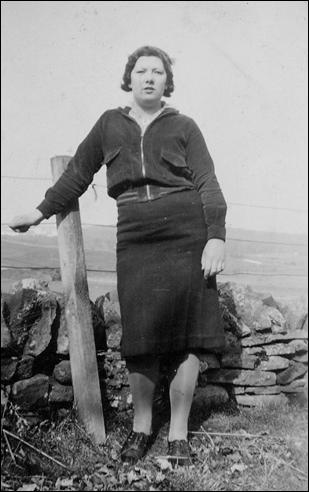
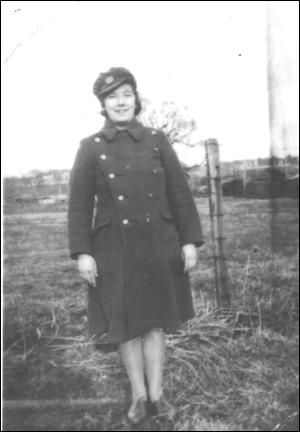
The Newfies
In
The Golspie site, a camp of prefabricated type, is now hidden by
trees which have been planted on the slopes of Ben
Bhraggie. It was formerly used by Honduran forestry
workers for over a year in 1941-42 but they do not appear to
have been very industrious and left the camp in a very poor
condition when they left. Apart from the normal wear and
tear and neglect it is said that they also indulged in some
wonton vandalism. After they moved on elsewhere the
Newfoundlanders moved into the camp in 1942 and brought a
completely different work ethic. They were very hard
working worked a five and a half day week at a rate of two
dollars per day. It roughly calculated that this would
have been about 8/6d as the Canadian dollar exchange at the time
was probably about 4/3d.
The
The movement across the
The main mode of travel at this time, in the 1920s and 1930s,
from
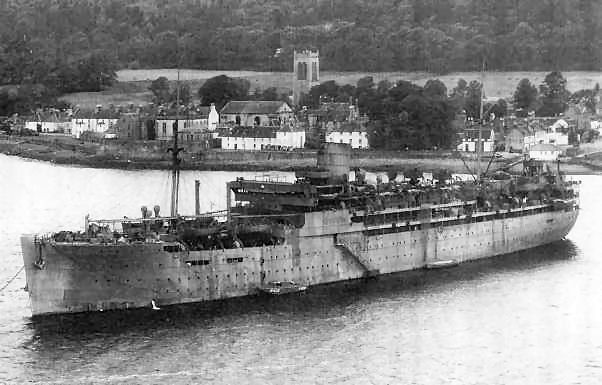
The Ettrick journeyed in
early July 1940 from Liverpool to
The SS Ettrick Convey HX 62, comprising initially 37 ships but
increased to 67 when joined by Sydney and Bermuda convoys,
sailed from Halifax on 31st July 1940 and
arrived in Liverpool on 15th August though she
most probably then proceeded to Glasgow as the convey record
records Glasgow as her final port of call and additionally my
father said that he landed in Glasgow.
The Ettrick sailed in the
middle of the convoy and it is reported that Commodore R B
Ramsey, as Vice-Commodore of the convoy and aboard the Ettrick,
said she was a great help in this position in keeping the convoy
together.
The Commodore's recorded comments are as follows:
"The convoy behaved excellently, and all did well.
The master of S.S. Lindenhall, Captain F. H. Wainford, (the
Commodore's ship) and his officers did everything possible to
assist me."
And he says there was "dense fog 3 hours after leaving
Apart
from fog and usual difficulties of keeping such a large convoy
together this voyage was without special incident while under my
command. I would like to say that Commodore R.B. Ramsey as Vice
Commodore in S.S. Ettrick was of the very greatest help and his
position in the middle of the convoy did a very great deal to
keep the convoy together.
With reference to the junction of
the Halifax, Sydney and Bermuda sections I suggest that the air
escort and local escort from Halifax of the Halifax portion
should on their return to Halifax harbour report how late (if
late at all) the H.X. portion is likely to be at the junction
with the other two portions and that Halifax radio should
broadcast this to the Halifax, Sydney and Bermuda portions, no
answer being required. Also, I think that the distance of 20
miles between the parallel routes is too great, and should be
reduced to 12 miles."
The SS
Ettricks end came on 15th November 1942 when she was torpedoed
by German U155 whilst part of a convoy in the
Aboard the
‘Ettrick’ again we were part of a 9-ship convoy leaving
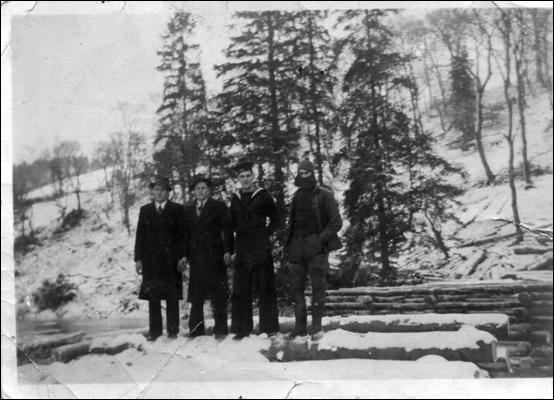
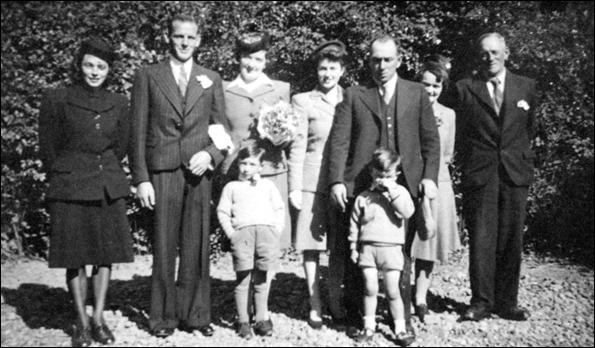
The wedding of my
father, Matthew Joseph Lannon, and mother, Annie Isabella Fraser
Melville at Dingwall in September 1945.
Left to Right; Joey
Melville (nee Angus, Cathel Melville’s widow), Matthew Lannon,
Annie Melville, Barbara Melville, George Melville (Wordie), Mary
Melville (nee Sutherland, Neddie Melville’s wife) and
Grandfather, George Melville. In the front; David Melville
(Cathel and Joey Melville’s son) and Don Melville (George and
Jessie Melville’s son).
THE ‘OLD’ HOUSE AND ITS SURROUNDS
The ‘old’ house, as it
was called, was the place of my birth on
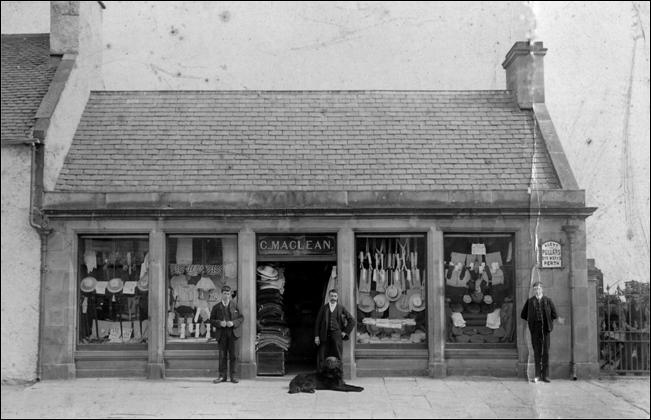
Above
is a picture of
The
house is now called Seacrest but prior to that was Tarbat
Cottage. It was
built as a single storey property in 1818 by a George Hendry
and had a second storey added in 1832 when the house next door
was built. This
adjacent property, known to me as Strathnaver but later called
Helensville, was built by the above John Low, a prosperous
merchant, and his wife Margaret and in 1833 they added a shop
to the west gable of neighbouring Seacrest/Tarbat Cottage. To
the rear of this building they built a byre, cart shed,
washhouse and stable and those additions or at least the
remains of some of them were well known to me.
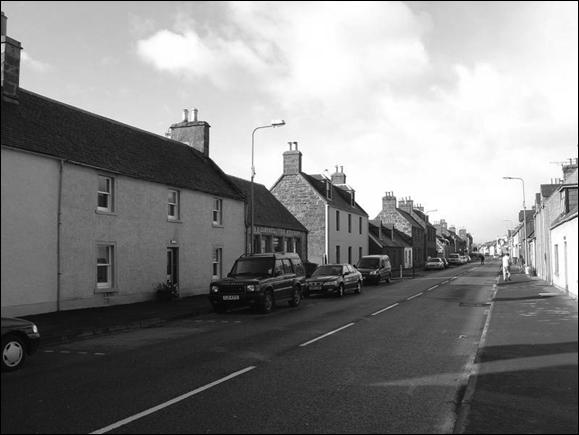
Unlike the new house the
home on
The living-room was not just poorly lit in the evening but also
had poor light during the day. The one window was small
and faced out onto Main Street. Traffic noise might have
been a problem had the roads in those days not been almost
devoid of private vehicles. The range was impressive and
well used and was the centre of activity. Bath night took
place there when the old tin bath was taken from its storage
cupboard and filled with water boiled on the range. Turns
were taken in the bath and the water not fully emptied but
topped up with hot from a very large pot on the fire as
required. Another interesting feature of this room was the
storage facility of past days in the form of hooks in the
ceiling. Those would have been used to hang hams and other
cured foods in bygone times.
The garden was to my eyes very large and probably by today’s
standards it was probably fairly generous in size. It
covered the area from the house down to the beach and stretched
behind the fish shop. It was well provided with fruit
bushes – black, red and white currents and gooseberries.
There were also fruit trees and a plentiful supply of rhubarb
. A pear tree grew up the outside of the back wall of the
house there was an apple tree nearby and further out in the
garden a plum tree. When we moved to our new house the
plum tree was dug out and transported to
Also in the garden there
was a hen house on the side nearest to the garden of the
adjoining house, ‘Strathnaver’. I do not recall how many
hens we had but I know there was sufficient to provide us with a
steady supply of eggs and our Christmas dinner. This
Chicken was our Christmas meal treat and served to provide stock
for the broth for the first course having been boiled before it
was stuffed with bread and onion stuffing before being roasted
with roast potatoes to complete the cooking of the bird.
The dessert for Christmas dinner was usually a Clootie Dumpling
made in traditional fashion in a piece of muslin cloth or indeed
any white material that was available. It seemed to steam
away in a large pan for hours but it was well worth the wait.
Served hot with custard it could be a meal on its own and served
cold it provided a lovely snack to have one its own or with
tea. And it was not just a Christmas food but also
frequently on the Sunday lunch menu due to the relative
cheapness of the ingredients and the ‘belly filling’ nature of
the pudding.
Access to the garden from
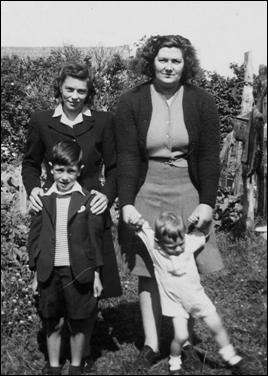
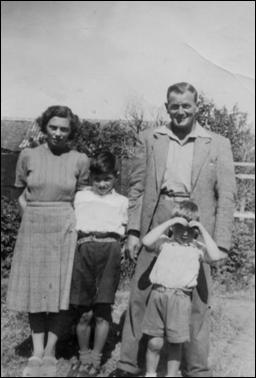
Further to the east and
across the next entry from
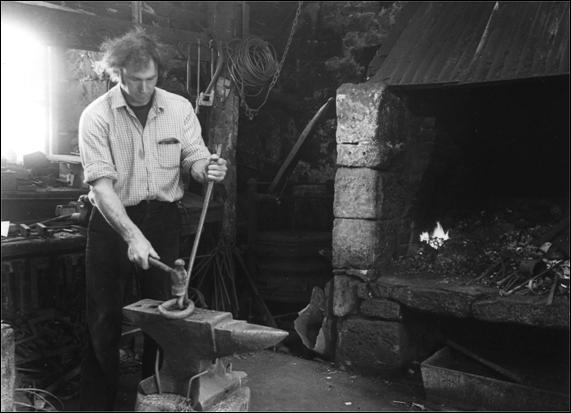
Two other places of
interest nearby were the Dairy and the Police Station.
Both were on the opposite side of
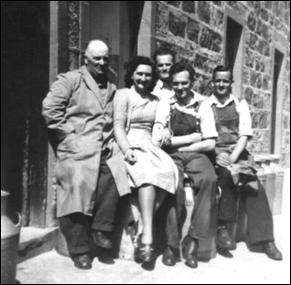
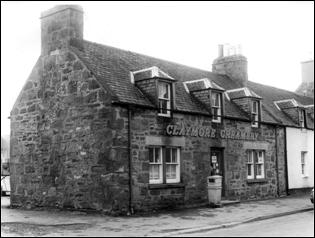
Outside the Dairy where
the Clydesdale Bank moved to and the next Dairy further west on
Fortunately, I only visited the Police Station cell on one
occasion and that was when the local bobby though I might like
to see what it looked like. After the Police Station moved
to new premised at the top of Lindsay Street my brother, Ian,
resided in the let our property until he obtained a council
house in
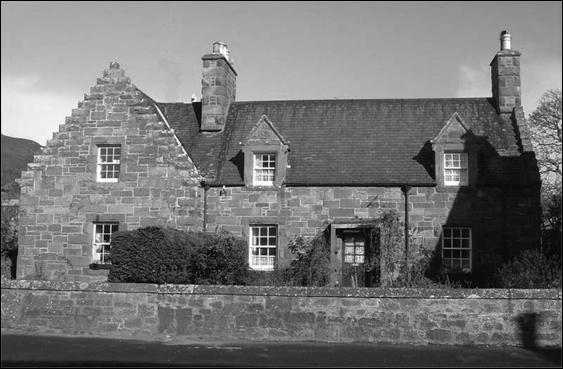
Police
Station on
At first there was
no sea wall there but during our time in the house the present
barrier to the sea was built. Though there was no wall
there was evidence of some wooden structures which had been used
to break the waves so that less damage was inflicted upon the
shoreline. Access to the foreshore was through a wooden
gate in a rough wooden staked fence leading onto a stony
beach. Beyond those large stones and shingle was a sandy
sheltered area within a rock barrier about 100 or so yards off
shore. On either side of the sandy bottom and beyond
there were areas of seaweed covered rocks and small pools.
Those areas were excellent for collecting whelks and for fun
while searching for tiny crabs and rock pool fish.
The contents of the garden were many and varied. Up the
house wall a large climbing pear tree grew with vigour and in
the garden there was a plum tree and an apple tree. I seem
to remember that my Uncle Cecil removed the plum tree to his
garden in
I remember a rather overfull shed to the right hand side of the
garden and a hen house down on the left side.
We had two pet dogs and
pet rabbit in my memory. Coolie a small black and white
mongrel was a quiet family pet sadly lost when run over by a
passing lorry on a snowy winter’s morning. I have a vivid
recollection of the dog lying by the side of the front door, of
my mother sobbing and the lorry driver apologizing and
explaining that the dog just ran in front of his
lorry. Coolie was replaced by a rather large black
dog of particular breed. He got his name from a white
patch across one eye. He did not least terribly long with
us as he became more interested in eating the curtains, rugs,
etc. The fine straw was when he ate washing drying by the
fire (including father’s underwear!) when the house was
empty. A visit to the vet confirmed some illness or other
and he was put down.
My rabbit lived in a run constructed by my father. The run
was moved around but generally was placed near to the foot of
the garden in a small lawn where my home made swing also
resided. The rabbit disappeared for some days and it came
to the attention of my parents that it had been taken by a boy
from
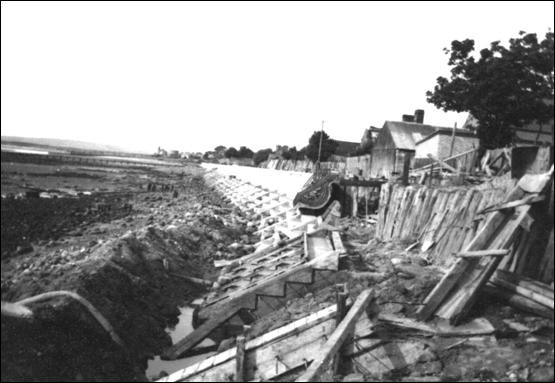
The seawall under construction about 100 yards to the east of our garden.
While living in
Bikes were much desired then, as now, but we all had to be
satisfied with old ones made up from a number of old
machines. I do not know where my first bike came from nor
indeed where any of the family bikes originated. Very
unlike presented bicycles, they were black with large, narrow
spoked wheels and handle bars that curled to the side – not down
like the traditional racing bike. Apart from the small
childs bikes which us youngsters got there appeared to be three
distinct types. My father had a normal sized bike with
wheels and frame not unlike in size the present bicycle,
grandfather has a higher and more old fashioned machine with a
bigger frame and wheels. He would set me up on it well off
the ground and push me around the garden and along the sand on
the beach. My mother’s bike was a very traditional lady’s
one. Possibly marginally smaller than the one for the male
of the species and with the traditional cut away cross bar that
swept down from below the handlebars.
The crossbar on my father’s bike was a very effective carrier
for me as young child. He would set me sidesaddle on the
bar and off we would go.
I talk about my parents’
bikes as though they had only one each but in truth they had a
number but consecutively. As one became unusable anther
second hand one was found to use as it was or to make a single
bike for the bits of those two maybe some others literally
hanging about in the shed.
MEAM’S YARD
My father work for
almost all of his working life after the Second World War with
the building firm of James Sutherland and Son. The family
firm were nicknamed ‘Meam’s’ derived, I assume, from a common
corruption of the name James.
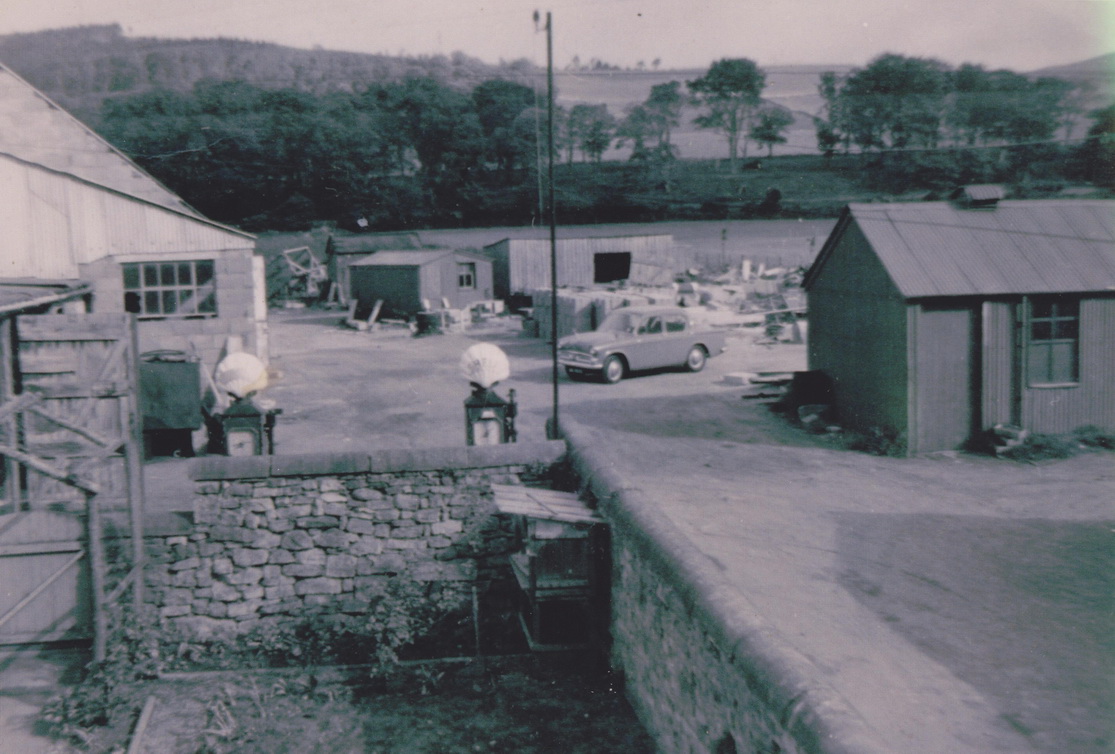
The yard taken from an upper window in the
Sutherland's house on Main Street.
The builder’s yard was
only a short distance along the
Concrete blocks for house building were produced in great
numbers but a laborious manual method. An oblong wooden
plate or palate large enough to accommodate one block was
inserted into a machine with four sides that flapped out
open. One inserted a lever was pushed and the centre area
depressed and the sides of the box came up to form a mould in
which a block was to be formed. Cement was shoveled into
the box and a heavy top plate on a high handle was used to
hammer down the mixture. Once this process was completed
the lever on the machine was pulled to raise the centre and drop
the sides revealing a perfectly formed block sitting on the
palate of wood. Each block was produced this way and set
out for drying and curing. Cement for the process was
mixed in a petrol driven concrete mixture which was filled by
one or two men using just hand held shovels.
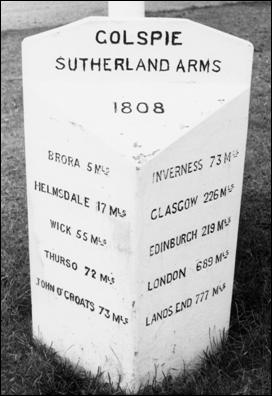
Other building materials
produced at the yard included, lintels and sills for houses,
kerbing stones and milestones. Those milestones can still
be seen on the verges of the Sutherland roads though they are
disappearing with the advent of modern signage.
One stone still in perfect condition is situated on the lawn
in front of the Golspie Inn, previously known as the
Sutherland Arms Hotel, in Golspie. This stone indicates
the miles to nearby and more distant settlements. It was
made by my father and his elderly workmate, Willie
Campbell. I am told that they put their names in an
empty tobacco tin and inserted this in the centre of the
mixture before completing the production of the stone.
The distances relate to the old road rather than the actual
distance to places, such as
My visits to the yard
were regular and sometimes extended as no one seemed to worry
about youngsters playing amongst the materials. I also
from time to time in the school holidays got the chance to
travel in one of the lorries when pickups or deliveries were
taking place. I remember on one occasion going to Dornoch
with Willie Urquhart (Hence) driving when the lorry started to
boil on the steep brae past Cambusavie. Willie found and
old tin can in the lorry and went into the wood in search of
water. The engine cooled, some water was obtained and we
continued on our journey. Another journey I recall was to
the Invergordon area for sand and other building
materials. I think that the driver on that occasion was
Bertie Mackay (Tit). The lorries to me seemed very large
and very impressive but by today’s standards they were very
basic and relatively small.
On one visit to Meam’s yard I remember Uncle Cecil getting quite
badly burnt. It was towards the end of the day and I was
there to meet my Father to walk home with him. As was the
practice, Cecil decided to wash the grime of concrete making
from his hands with petrol. He carried out this as usual
but shook his hands in the direction of a fire burning in an old
drum specially air hold for the purpose to provide heat on the
cold winter days. The petrol ignited and traveled up the
spots of liquid from the fire to his arms and the petrol
remaining on his hand and lower arms burst into flame.
Cecil instantly flung himself in the pile of sand nearby to
extinguish the flames but not before he had severely burnt his
arms. He was taken to hospital where he was treated for
his injuries.
Another intriguing activity at the builders yard was watching
Harry MacKenzie, the firm’s mechanic, working on the company
vehicles. Harry worked in what to my eyes appeared to be a
large garage on the left hand side of the premises and just
passed the small office and behind the Sutherland family
house. Vehicles in those days were very basic mechanically
and tools were few with a big hammer appearing to be the most
important. However, it was very impressive for us
youngsters to see the technicalities of taking apart engines and
gear boxes and to observe the changing of messy oil and the
repair of burst tyres.
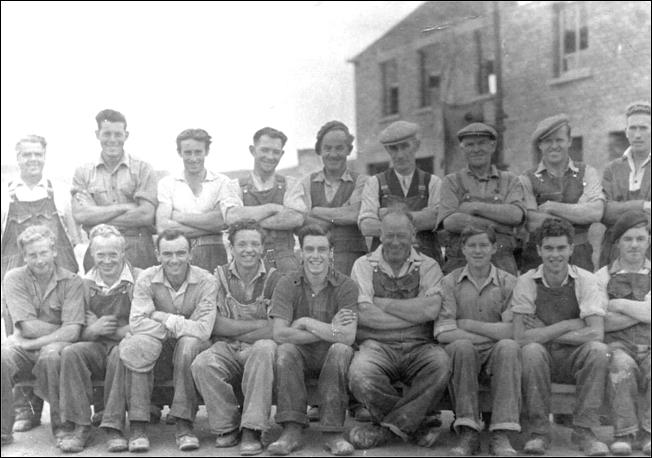
Meam’s business was a
thriving one and there was quite a large workforce due to the
need for new housing after the war. The picture above
shows some of the workforce and its appears mainly those
involved on the actual house building as opposed to those in the
yard. My uncle Neddie Melville, the site foreman, is
seated fourth from the right and cousin Freddie Melville is
standing second left.
The full list:
Back left to right – Jackie MacKintosh, Freddie Melville, Donald
Budge, Michael Bonner, Robbie Gordon, Jocky Mackay, John Ballie,
Donnie Gunn, Desmond Fraser.
Front lft to right – Jackie MacDonald, Alan Murray,
Donald Stewart, Hector MacDonald, Neil MacBeath, Neddie
Melville, Ian Christie, William McDonald, George Manson.
Meam’s yard is no longer
there, of course. The business hit financial problems and
was taken over by Alexander Sutherland’s and this business was
in turn taken over by Morrison’s of Tain. My father
reluctantly moved from his place of long time endevours less
than half a mile along the
SCHOOL
DAYS
I remember my first day at school well or at least
my getting there and going home. I waited
with great excitement for a number of weeks before going and was
determined that I would go on my own. In the
event my cousins from the Mound, including Neil who was just a
year older than me, arrived at about
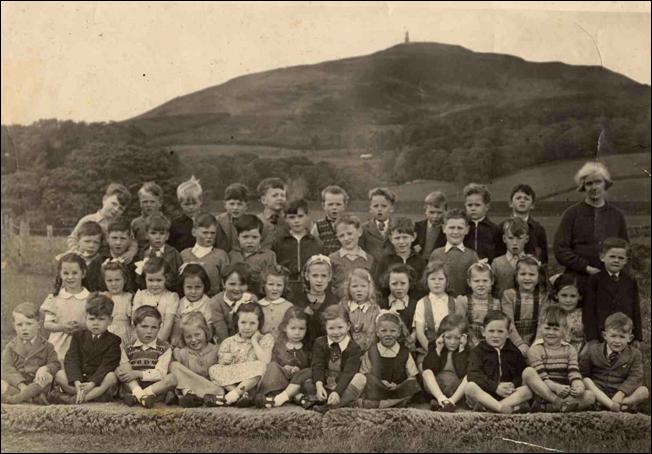
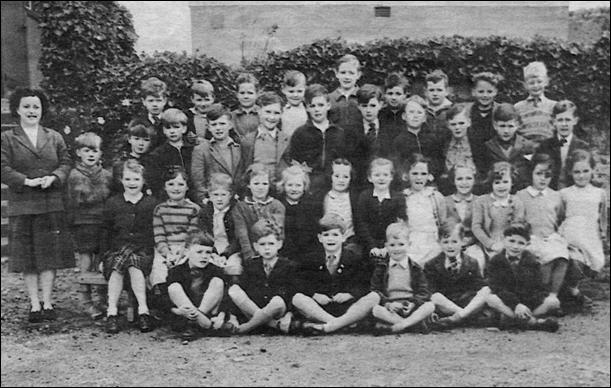
I remember often going to play in those fields when no crops
were planted and also have memories of being taking by cousin
Freddie Melville to the top boundary of the field with the
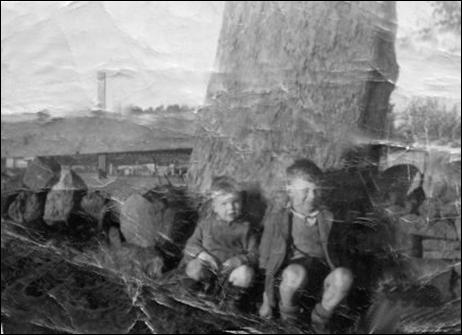
Ian and
myself pictured by the big tree in the fields behind
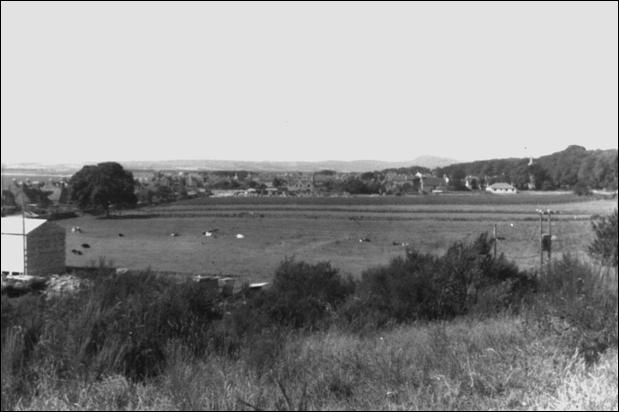
The view from
the primary school, across the field where the High School was
to be built, towards mean’s Yard and
Primary School
I was well acquaint with
the Primary School before I got there as it was a favourite
place for a family wander on sunny Sunday afternoon. The
buildings on the outside were not a lot different from the
way they look now. There was, however, a large
grass area running in front of the main building separated from
a shrubbery by a roadway running the length of the building.
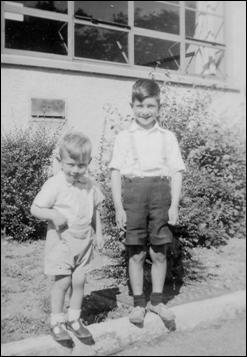
Jean
Seaton
P1 teacher
Irene
Ross
P2 teacher
Sarah
Ross
P3 teacher
Alix
Beaton
P6 teacher
Connie
Horne
P7 teacher - the qualifying or control class
The P4 and P5 teachers I cannot remember so they could not have
made a great impression on me. Though since there
was tendency at that time, in a school of the size of Golspie,
for large composite classes to be formed. I well recall on
occasions finding my cousin Neil Melville in the same room and
at other times cousin Cecil Melville sharing a classroom.
Since one was slightly older and the other a little younger this
situation was brought about by more than one age group in a
room. The pictures of the classes taught by Miss Seaton
and Miss Ross would seem to indicate pupils of more than one
age.
Mr MacRae the Head Teacher when I started I remember well - not
least because I pushed a snowman he had helped to build with us
down as the break bell went. Mr Rutherford, 'Willie A.',
came after Mr MacRae and he was a man I much respected. He
was my Head Teacher also in Secondary School and impressed me
because he always asked after me even long after I had left
school.
The Primary School/Senior Secondary School Janitor was George
Sutherland who went by the name of ‘Geordie Monkey’.
Geordie really did rule the school – if one was not behaving
inside on a wet break his extending three foot rule cracked
across the knees to enforce a seat on the radiators or heating
pipes running around the cloakrooms.
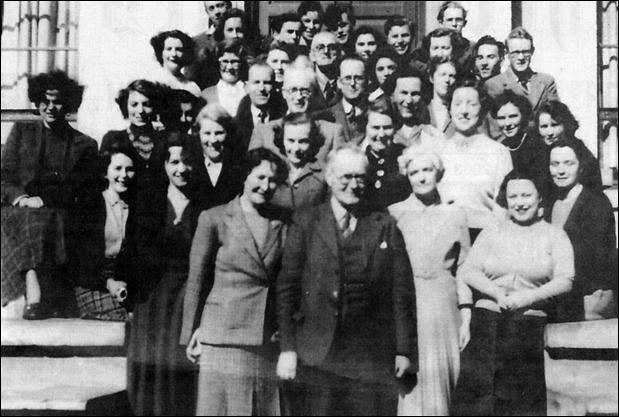
Senior Secondary and High School
I probably became a teacher because I did not want
to leave school. I
always found school enjoyable and though I did not work very
hard and probably did little homework I had little problem
getting through the experience. That does
not mean I was very successful – it just indicates that I got as
much out of it as I required at the time and just as much or as
little as I deserved. I think
that if I had worked as hard as some students do now I could
have been very successful. However,
it was just not the way things were for the majority of teenage
pupils in my day.
In the fifties, the sixties and before class or occupational
status of parents had a significant influence on educational
achievement. Aspirations
varied between the different sectors of society and while ones
station in life was not irrevocably placed there was a certain
degree of predetermination resulting from the afore mentioned
place in society. Fortunately,
changes were beginning to take place in the value placed upon
education by all classes and the working class families were
starting to becoming more adept at ‘bucking’ the system.
As a pupil with an enquiring mind Science subjects were a
clear preference. The
example from home related to the practicalities of life and
Technical Subjects were a good choice and an intense interest
in Geography and travel made another subject choice
inevitable. History
would also have been on the agenda if timetabling had not
resulted in a choice between History and Geography. Indeed
timetabling was quite a restriction to choice in those days
while today although there are some limitations the problem is
not nearly so great. English
and Mathematics were taken because they had to as was French.
The former were coped with quite adequately while the later
was of little or no interest to me. It is
interesting to note that while my mother had to leave school
at 14 years old in the 1930s she did, in fact, pass the
equivalent on the 11+ and study French. Clearly
she had some ability but being the youngest of nine children
staying on at school was an impossibility.
My Secondary School career began in the same buildings as my
Primary Education finished. Golspie
Movement through High School was relatively uneventful. I took
most subjects in my stride without any particular success to
‘write home about’. I now
have difficulty remembering the staff but the most respected
ones or those we loved to hate come to mind most readily. The
names of most of the ‘middle ground’ have dimmed with the
passing years.
Some that come to mind and there subjects when I can recall
those;
Miss
MacLeod Mathematics
Mrs
Gibson Mathematics
Mr
Thompson English
Mr Walter
Henderson
English and
History
Miss Betty
Paul Geography
Mrs
MacKenzie
French and
English
Mr
MacLeod English
Mr
Syme French
Mr
Fyfe French
Mrs
Davidson Science
Mr John
Lowe Science
Mr
MacLeod
Classical
Studies/Latin
Mr
Mr
Foot Music
Mrs
Kinghorn Music
Mr Tom
Paterson Technical
Mr J
Mowat Technical
Mr
Laird P.E.
Mr
Dalrymple P.E.
Mr Norrie
Brown P.E.
Mrs Juna Sutherland
(Ross)
P.E.
I may have some subjects wrong, some may have taught two or more
subjects and certainly not all worked in the school at the same
time.
Janitor Downie MacDonald
was well liked school caretaker quite different in his methods
of discipline from the previous incumbent. He was,
nevertheless, liked and respected and was also an asset to the
local Golspie Football Club and the village as a whole. He
was one of the ‘leading lights’ in the football setup and also
prominent in the early Gala Week arrangements. My brother
Ian followed him as principal Janitor at the school.
In school I participated in a variety of sporting activities
having an eye for a ball and being half decent at many different
events was advantage at gym lessons. Though a ‘jack of all
trades’ and ‘master of none’ the participation was enjoyable and
the standard reached acceptable enough on a local and sometimes
even a county level.
Some of the activities are mentioned elsewhere but worth noting
here is my interest in cross county running during PE
classes. Our route generally took us out through the
Sports Day
School Sports Days were
looked forward to with great excitement. Up until the
opening of the new school and the completion of the grounds the
Sports were held in the King George V playing field. The
whole school would be marched along the
I particularly liked and
had some success in the middle distance races and the field
events. High Jump being my best and shot putt being to an
acceptable level. Long Jump was never a favourite and lack
of sprinting speed was probably one of the reasons for lack of
success.
At the end of the sports either the Head Teacher or some other local dignitary presented the House Shield to winning house. I was in Silver Rock, the other houses being Ben Bhraggie and Dunrobin.
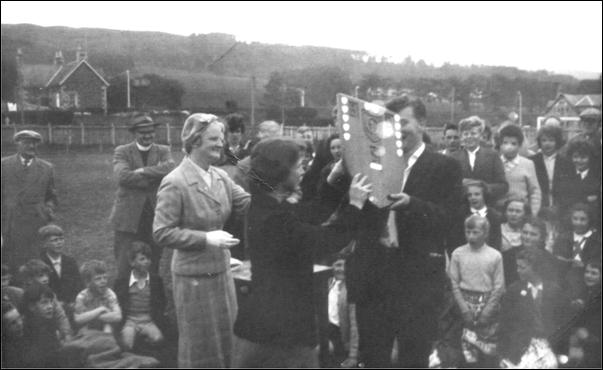
Mrs Sutherland, Seaforth
Road, I think, presents the prizes at the sports about
1960. Some of the faces I recognize. The Minister to
the rear of Mrs Sutherland is the Rev. Alston of the Church of
Scotland.
The Dornoch Games
I never go to the
Dornoch games nowadays, even too watch. Maybe I will make
a return visit sometime to see if it really is exciting as I
thought in the late 1950s and early 1960s. Going to watch
was a fairly regular occurrence as we were able to combine a
visit to the games with a call on Uncle Willie and Aunt Nellie
in
Aunt Nellie was a very
big, imposing woman with a somewhat loud voice but thoroughly
kind with it as far as we were concerned. Uncle Willie was
pleasant and generally as quite as Nellie was loud. A
butcher to trade with Grants of Dornoch in their Dornoch or
Golspie shops at that time though later to work in Ardgay and
maybe elsewhere.
I recall one occasion
when I participated in the games as a ‘professional’ runner – I
also have a vague recollection that I had earlier taken part as
a very junior participant in the children’s local events.
My professional debut lasted the one occasion as Donnie Findlay,
Co-op Shop Manager, and Norrie Brown, School PE Teacher, for
different reasons warned us off taking further part.
Mitchell Mackay, now
living in
The Ragman
Strange though it may
seem the Ragman brought some excitement when his bell or horn
was heard. In my memory he did not arrive by horse and
cart though I don’t think his ancient mode of transport had not
been long abandoned. The usual Ragman’s vehicle was an old
van with side windows quite like that of modern ice-cream vans
but of a much older vintage and in very poor mechanical shape.
Whenever the call was
heard, and often the message came by word of mouth before the
call was heard, the search was on for old rags.
Cupboards were turned over and clothes that might have been
serviceable and hour earlier suddenly became unwanted.
Arguments raged regarding what could and could not be given
away. Wool was really what was wanted but a few other
fabrics were acceptable and even the poorest garment might
elicit a balloon from the trader.
Usually we all danced
around the van excited by what was being dispensed and only
mildly unhappy when a bundle of hard won clothes only brought a
meager prize. Like the sideshows at the fair, the most
sought after exchanges seemed to stay on the shelf there just to
tempt the customer to search even further for the desired
material.
Comics and other writing matter
My principal reading in
my young day from about the time I could read on my own are best
described as Comics. The ones I remember are the Beano,
Dandy, Topper, Beezer, Hotspur, Wizard, Adventure and the
Rover. There was also the Eagle which I rarely got myself
as it was more expensive and somewhat ‘up market’ but I did get
a copy from my friend in primary school, John Stewart.
John went with his Father, Mother and brother James to live in
The first two, the Beano
and the Dandy, were bought when I was in
When a little older in
The Sideshows or Circus
The Sideshows that came
were often commonly called circuses though of, of course, they
were in no way like or related to the circus. Indeed,
occasionally circuses did come and we still just called them
that. The terminology did not seem to matter but what did
matter was that this was yet another excitement, something
different.
The shows set up in a
few different places over the years but again in my memory they
were in the field beside the present football pitch.
Sometimes to the village end and sometimes to the golf course
side. I believe that not long before I remember them
coming that they were in a field behind the main street in the
area of what is now
Generally there were a
few stalls with darts, shooting, rolling balls, hoopla,
roll-a-penny, etc. and what would today be called ‘rides’
However, fiercesome though they might have appeared at the time
they bore no relationship to the present. There were swing
boats which if you were very brave you could pull with two hands
and so not have to hold onto the side bars, there were
roundabouts of a sort like present day waltzers but slower and,
of course, the dodgems.
Those rides required
patient queuing, particularly on a Saturday night after the pubs
had closed or the pictures came out, and if you were very lucky
a friend might keep a car for you when he had expended his cash
or satisfied his need for a dangerous thrill.
No one ever seemed to
win the big prize at the darts, the shooting or the hoopla and
if you did then you were accused of cheating. Of course it
was possible they would say but you couldn’t have done it.
Hercher’s were regular
visitors and Wallace’s too with a later arrival on the scene as
I remember, Spencer’s. They brought the showground bingo
and the crowds flocked in. I think there was a father,
mother and two sons, one of whom was in my class in school, and
they enlisted the help of locals to man the stalls. Quite
often those who took jobs were from families who were less well
off or who had a ‘hawker’ background but had now settled to life
in one place.
On a few occasion I
remember a large show arriving with many stalls and most
impressive of all the wall of death. Motorcyclists
speeding round a vertical, cylindrical walls at high speed and
occasionally taking on a brave volunteer. I am told my
uncle George (Wordie) once accepted the challenge. On one
occasion when such a show was present there was also a boxing
booth with all-comers asked to challenge the resident
fighter. Those that took up the challenged appeared well
beaten and yet the resident champ did not appear terribly
fearsome from a dozen rows back in the audience.
The Circus
Though Circuses did come occasionally my memory of
them is rather vague. I really do not remember
much about the shows and recall more at least one visit to
Cunningham’s Christmas Tree
Every Christmas
Cunningham's shops in Golspie and Brora had two Christmas trees
with presents for boys and girls. The trees were situated
outside the shops. In Golspie the girls' tree was
generally to the right of the front door as you faced the shop
and the boys one to the left. The shop itself was situated
on
In the weeks running up
to Christmas tickets were issued free by the shop for all
children in the village and it was a matter of much concern if
the ticket was not picked up by one or other of the parents in
good time.
The draw for prizes took
place on Christmas Eve unless this was a Saturday and in such a
situation the draw would then be on the 23rd of December.
Santa drew the tickets from the pails clearly indicated as
‘boys’ and girls. This chief guest at the proceedings
arrive in some surprise fashion each year. Alec
Cunningham, himself, gave a talk to the crowd and when attention
was drawn by him Santa appeared somehow in a ‘flash of
light’. On one occasion our eyes were diverted to the sky
to see his helicopter and when we again looked towards the shop
door there was the man in red.
There appeared to be
about 15 to 20 prizes on each tree and as names were drawn
from the pails the winners went up to choose a prize and, of
course, be greeted by Santa.
At the end of the draw
all children lined up to receive a bag of ‘goodies’ from the
shop assistants. the bag always contained some fruit and a
small toy or game.
We could never
understand at that time why the first name out of the boys pail
always seemed to be Hector Sutherland. He was not young
but later we realised that Hector was disabled and always
received an early gift.
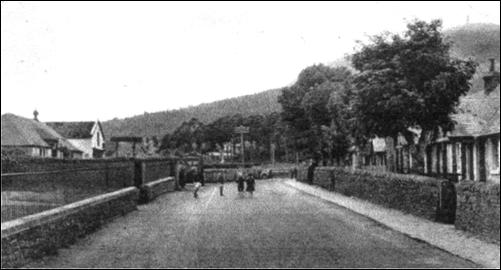
Cunningham’s
shop was up there on the left. I do not have a
picture of it but no doubt there is one around somewhere.
Bowling Green
I do not remember a lot
about Bowling Green Fetes as we called them. The annual
fun day and fundraising event run by the Bowling and Tennis
Club. It certainly was a day to look forward to at a time
when such events were few and far between. I recall stalls
and games in the grounds of the Bowling Club and teas in the
clubrooms. The whole area inside the walled area of the
Bowling and tennis Club was a place where children could have
fun laying in the rows of thick bushes and small trees.
All this foliage surrounding the bowling green itself is
now all gone – in the interest to reducing the midge and other
flying insect attack on the bowlers I am told!
When somewhat older than
the time when the fetes were held I became more active at the
Bowling and Tennis Club. While from time to time I had a
go at bowling using the clubs bowls I was more involved at the
Tennis Club section. I played a lot of tennis and in my
school teenage years was on the Tennis Committee for a
time. Cheap tennis rackets were the order of the day and
they did not last very long with the strings or even the frames
frequently breaking. They were often bought from
McPherson’s toy shop across the road from my house first house
in
The Harbour
The harbour, or rather
the pier in Golspie was a popular place to visit. There
was an old wooden structure which was very unsound and attached
a ‘new’ concrete pier. The harbour was at the west end of
the village just off
In my memory the harbour had only some small boats and four or
five fairly seine net fishing boats one of which I seem to
recall was naked Silver Rock. Jumping from boat to boat
and fishing for sellags or cuddings of those boasts or the
harbour was a favourite pastime. Sometimes we would fish
from the top of the harbour and on other occasions from
underneath the structure which was somewhat hollow with a
concrete base and pillars supporting the upper structure.
A good catch would be 50 or so very small fish and a couple of
good sized cuddings. The cuddings could be eaten but the
flesh was very dark and indeed almost black. The picture
below shows the old Golspie Pier, somewhat before my time, while
my activities were around both the old wooden structure and the
attached new concrete pier.
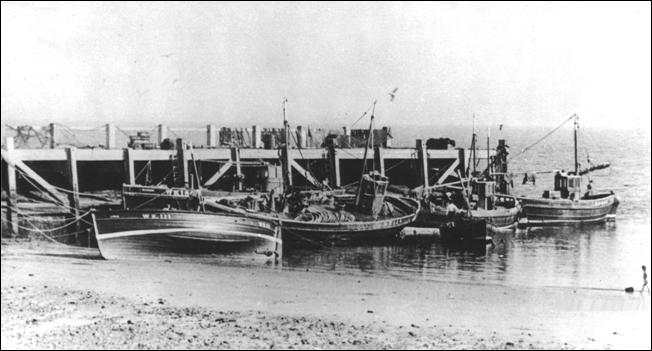
And, of course, there were our own circus acts and
side shows under the harbour led by ‘Ringmaster’ Tony Rettie. Talking of
Tony, another favourite pastime was the football shooting
competitions in the specially set up nets in his back garden at
The Golf Course
The Golspie Golf Course
was, and still is, a fine 18 hole one. To the west of the
village and accessible by
The first golf club house remembered was a little way onto the course past the Golf Links Hotel. It is no longer possible to find any sign of it the structure having long since disappeared under the sea and now a substantial distance off shore. It was by this club house that the Coronation bonfire of 1953 was lit and there that the cup and prizes for the first Ben Bhraggie Hill Race were presented. The winner was Teddie Munro. The race started in the nearby football pitch and after a route along the back road, past Rhives farm and up the face of the Ben the race finished at the same spot.
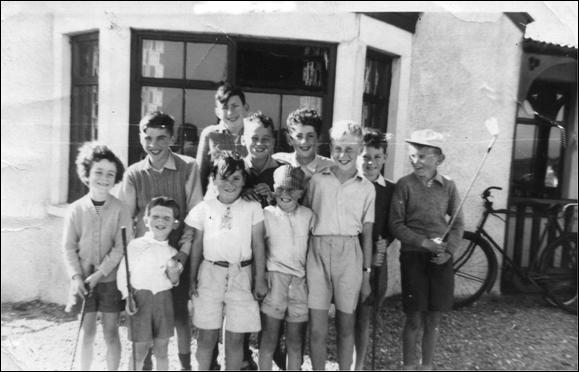
The Junior Golf Group
captured on camera by Mrs Baxter.
Left to Right Back Row:
Christopher Yuill, Allan Lannon, John MacKay, Walter Yuill,
Unknown, ‘Boy’ Baxter.
Left to Right Front Row: The first two I am not sure of, David Melville (Hank), Donnie Christian, Sandy Campbell.
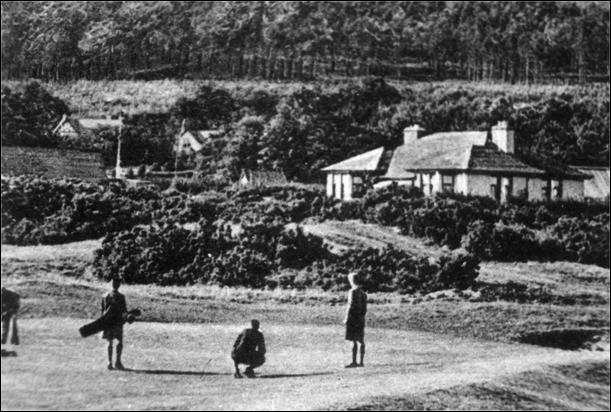
What was
in my young days the first green with
Up the Ben
Ben Bhraggie dominates
Golspie with the 1200 feet high hill standing directly behind
the village and casting its shadow over the area below.
Atop the hill is the high and impressive monument to the First
Duke of Sutherland, George Granville, the man principally
responsible for the worst of the Highland Clearances in
Sutherland. Over there years there have, in fact,
been regular calls for the removal of the statue and its
replacement with something more appropriate such as a Celtic
cross. Local opinion, however, has always been that the
statue should stay despite the connection with a disreputable
past.
The ‘Ben’ was the sight
of a variety of leisure activities. It has served as a
place for walks, climbs in winter, cross country runs, play
areas for youngsters and even the launching pad for hang
gliders.
The larger part
slopes over the years have been treed to various levels.
Those areas being exciting environments for children’s games and
building of gang huts. The most popular area for such
activities was in the section known as the hospital wood but
other areas were also frequented by the youth of the village.
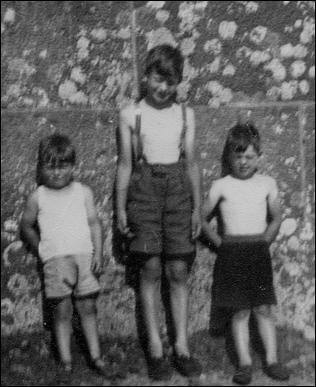
David Melville (Hank),
Allan Lannon and Ian Lannon at the Duke’s monument on the top of
Ben Bhraggie. The date would probably be about 1955.
Walks
With no TV prior to 1959
the main Sunday activities were church in the morning and a
family walking in the afternoon if the weather was
suitable. In inclement weather it was not uncommon for my
father to go to bed for a couple of hours or so and Ian or
myself might often join him or go to our own beds. Usually
those walks involved all four family members. The
favourites are listed below. Sometimes the walk was to
just one of those place but on other occasions a longer round
trip might be the order of the day.
Diary
The
The Park is the area of
a hundred or two yards width running between the wood and the
sea. An area used for grazing cattle and sheep from time
to time and also on occasions a horse or two. A grassy
pathway leads from the gate to the
The Park was also a
favourite spot for Boys Brigade camps in the fifties and
sixties. Many groups from
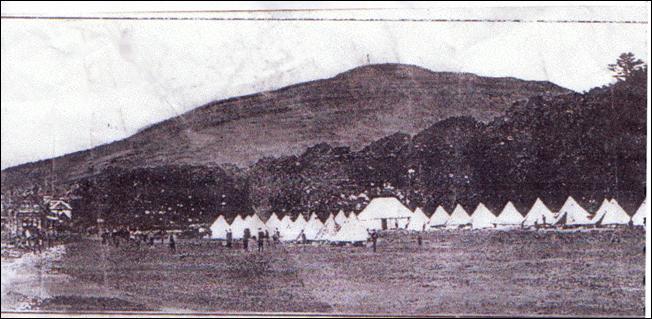
Walks in the Dairy Park
and the Dairy Wood were very popular. All sorts of
inventive games were played and many friends met. The wood
was particularly enjoyed and hiding games in the tree were the
order of the day. The wood concealed two areas with
monuments which had been erected by inhabitants of the
castle. We always seemed to visit those landmarks.
One, near to the castle boundary, was on a raised piece of
ground an gave a particularly good view towards the castle
harbour and the sea. The castle harbour, washed away
recently, was used in my memory only occasionally by yachts and
the occasional small boat. It was situated towards the
north end of the castle seawall and below a roadway leading past
an estate cottage up to the Dunrobin Castle itself.
Dunrobin
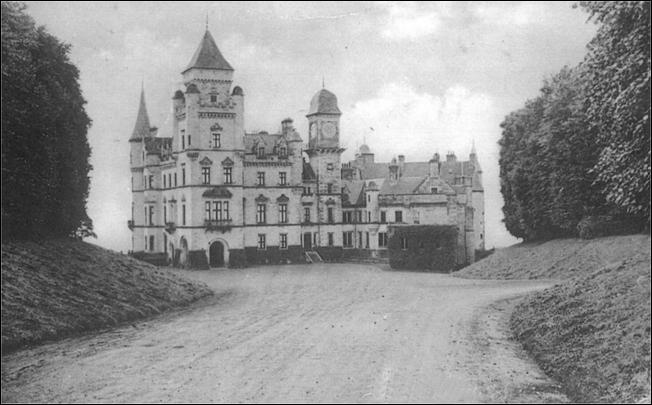
Big Burn and Skating Pond
I suppose the best known
Golspie walk must be the Big Burn. The paths and series of
bridges through the lower part of Dunrobin Glen and following
the course of the Big Burn have always a place of recreation for
local and tourist alike.
It was a very popular
walk with our family when we were young. Sometimes the
family only went as far as the open ground beyond the railway
bridge on other occasions the Falls would be the target of our
jaunt. At the time the bridge to the south side of the
burn approached past the Sutherland Arms garage did not
exist. The only route was through the Golspie Mill
property and by the Mill Pond.
Over the years the area
became one for playing with friend and for fishing. The
paths, though not as numerous as now, provide access to the
skating pond and the falls and lead to many secret haunts in the
hazelnut laden trees. Though at times we did progress
beyond the falls this was more unusual as the path beyond the
falls was not as well developed as now. Fishing pools in
the stretch between the falls and the next Big Burn road bridge
was generally the main reason for hiking beyond the Falls.
The Mill
A walk around the mill
and mill pond was generally a detour from the main Big Burn walk
though on occasions a walk to the Mill alone did take
place. As with Big Burn excursions, I would go in my early
years as part of the family and later I was accompanied by my
peers. The mill pond seemed very large and when the gate
was open to release water there appeared to be a substantial
flow. The mill wheel often seemed to turn in those days.
There were ducks on the
pond geese around the edges and many hens spread throughout the
nearby trees and bushes. Indeed, many laid not in the
sheds but on the grassy slopes as far across as the mill brae
down which the main A9 road passed.
In addition to poultry there were various other animals around the mill but most intriguing to us were the pigs. We watched them feeding, rolling in the mud and feeding their young. The largest ones seemed so big and so filthy dirty.
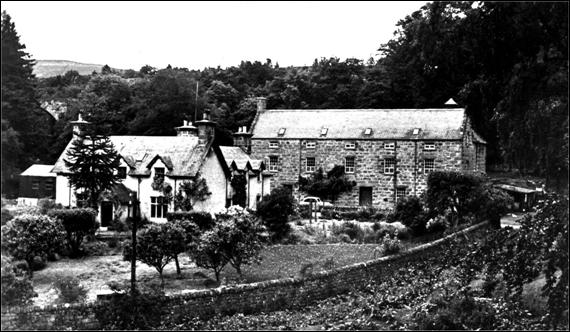
Fishing at the Big Burn
The Big Burn seems to
have much more water in it in those does. Possibly due to
trick of the memory it appeared to flow with greater force and
the trout looks much bigger than the few one sees now. It
is, in fact, likely that the burn did have a greater flow as
since that time a new and higher dam at Loch Horn has been built
and the amount of water entering the burn from various sources
appears to have diminished.
There was a number of
favourite places to fish. The ‘wide’ stretch at Tower
Lodge by the
The Culmaily Burn
The Culmaily Burn was a
small narrow burn but it did have some reasonable trout in it
and the occasional sea-trout coming up from the Fleet. The
burn originates in Loch Lundie but most of my fishing was in the
stretch from just below the Ferry Wood bridge to where the burn
entered the Fleet. There was always fish to be had and the
worm was the best bait. Half pound trout lay in the pools
below the banks. On one occasion when I went fishing there
with my father the burn was in flood. However, the water
level dropped quite quickly and after an hour or two of
unproductive fishing we started to catch trout. We ran out
of worms during the day and I cycled back to the garden to get
some. Eleven trout in all were caught.
Journeys to the burn
were generally made by bike as were most travels on any distance
outwith the village. Not a sporty type machine but a put
together, second-hand machine much different from today's
technological wizards.
Worms were generally dug
in the large corrugated iron compost heap behind the garden
shed. The garden produced wonderful vegetables - potatoes,
cabbage, lettuce and carrots - and the remains and other
compostable materials made a perfect breading ground for large
worms.
The Glen
Walks up beyond Backies
and area of the Big Burn close to the Newfie Camp were not all
that frequent but on occasions we went as a family up to the
branch back along above Dunrobin Farm. I also recall in
early teenage years going on ‘expeditions’ around the back of
Ben Bhraggie and down the rear slopes into the Glen.
Sometimes those expeditions would go as far as Loch Horn and, of
course, we did from time to time go to Loch Horn with for the
express purpose of fishing for brown trout.
I remember going on one
snowy day up the face on ‘The Ben’ and then on to the loch at
rear. It was frozen solid and we played on the ice with
little fear or understanding of the dangers of being on the
frozen loch. We saw many deer on the hill as we moved
through the snowy heather beyond ‘The Mannie’ and down to the
upper reaches of the Big Burn where it crossed the Glen road
after its exit from Loch Horn.
The Ferry
The Little Ferry is
accessed via the road that marks the upper boundary of the Golf
Course. Walks to the Ferry itself were less common when I
was very young as the distance there and back was a little much
for the afternoon outing. However, we did on occasions
make the excursion with Ian pushed along in the pram.
Later I went by bicycle and certainly it was an great spot for
fishing for sea trout down by the point at the mouth of the
Fleet.
Sometimes with friends I
walked the shore line to the sea side of the rifle range and by
way of
By road one had look out
for a renowned resident of the Ferry known to us as Flash
Gordon. I no longer recall the type of sports car he drove
at high speed around the area but it was best to step aside when
he approach on the Ferry Road.
The Golf Course and Beach
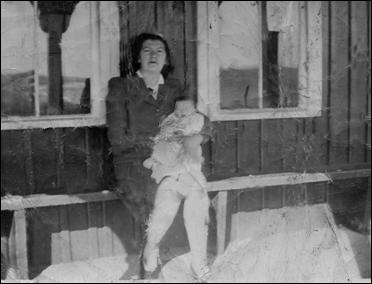
There was no Sunday golf
at that time and so walk along the golf course to the Lochie was
a safe excursion. At the Lochie, which was a very small
water hazard at the then ninth hole, we would look for lost golf
balls. After a competition it was not uncommon to find
balls though the number of searchers was always greater
then. The Lochie water hazard was split into two by a
narrow pathway cutting through it to the green. By this
path and around the edges reeds hid many golf balls but with a
little raking with hands or sticks some would appear.
Balls in the middle were accessible only by wading. The
water was not very deep but it was cold even in summer.
Balls were felt with the feet and then carefully removed.
At many holes we would
walk the rough again keeping a careful eye for the result of
wayward shots. The beach was also a favoured spot and on
the open sand or amongst the shingle we would spot the odd golf
ball. The fairway was, I think, easier to hit in those
days, however, as the coastal erosion had not reduced their
width to their present dimensions.
Often in the warmth of
those summer days which always seemed better than now we only
walked along as far as the first grassy hollows. There we
would lie and rest for an hour or two. If a 120 film had
been put in the box camera we might be lucky enough to get our
photographs taken. Some of those hollows no longer exist
as, like the fairways, they have been affected by the continuing
coastal erosion.
The Hospital Wood
One of the favourite
play places around Golspie was the Hospital Wood. Not
quite as it is now. Then the wood came right down to the
main A9 between the hospital grounds and the large property
inhabited by 'Gordy' Sutherland - his daughter Sandra was in my
class in school. I had not seen her for many years until
she appeared around the year 2000 at a New Year function in
Dunnet Hall, along with her cousin from Corsback, Angela Lewis,
Entry to the wood was
generally up a narrow, rough path from the main road. We
did sometimes enter from the 'Tech' end or across the railway
line behind the Back Road Wood.
Half way up the path
between the house and the hospital property was a small
stream. A couple of other streams cut through the
wood. A lower section of the wood was fairly open with
high older tree which were well spaced. The terrain was
rough and though uphill was also rolling so giving lots of
hiding places for games. There were a couple of areas
which appeared to be old quarries where sand or gravel had been
removed.
Further up the wood the
trees became more dense and to the south or
The evergreen trees went
quite a long way up the face of Ben Bhraggie with the main
ascent in this area being up a wide cutting or fire break to the
deer fence. The deer fence was scaled by a high style and
on the upper side there was a road which circled round the
hill. Rather than use this road the route from the
hospital wood to the hill top was by a rugged path. The
same path that was joined if the ascent of the ‘Ben’ was to be
made by way of Rhives Farm.
During my time in school
new house were built beyond the larger private properties and
closer to the Technical
The Railway
Nowadays it both unsafe
and an offence to walk on the railway line but no one seemed to
be bothered about that when I was young. On a Sunday there
were no trains and it was not uncommon for families to walk
along the line. The favourite route for us was from the
station or the Back Road Wood to Dunrobin. Sometimes the
walk would end at the high railway bridge at the Mill while on
other occasions we would walk to Dunrobin Station. Return
might be by the same route or by the road.
Walking the railway was
easy and steady due to the positioning of the wooden sleepers
and need to step from sleeper to sleeper at a steady and
regulated pace.
The railway was also a popular place for picking raspberries and brambles. Both grew in abundance on the slopes to either side of the line. My father was a regular harvester of both fruits and made large quantities of jam. Trains frequently blew at him to get off the line!
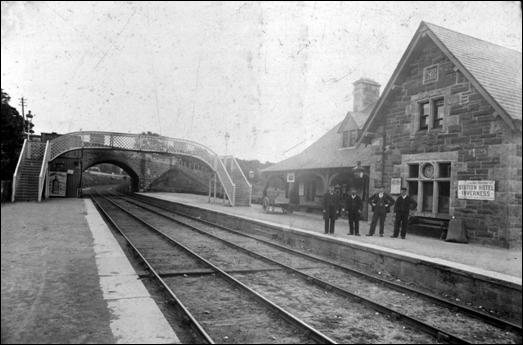
A picture
of Golspie Station and some staff members but taken a bit before
my time!
The Mound
Uncle Johnnie Melville
and his wife Lucy lived at the Mound in one of the station
houses. Johnnie had worked at various places over the
years with British Rail the principal ones Boat of Garten,
Rogart and the Mound. They had 10 children and so a visit
to the Mound was always a very social affair.
Usually it was just my
mother, Ian and myself who went visiting. We went and
returned by bus but occasionally we might use the train for one
leg of the journey. On one occasion I had to return on the
train on my own. I’m not sure how old I was but not much
more than nine or ten probably. I had gone up the Mound
Rock with some of my cousins to see the work on the placing of
electricity pylons and we waited too long. My mother
decided to return home and made arrangements for me to be put on
the train. With the family connections and the fact that
then trains were quiet and there were few dangers from strangers
in those days it did not seem a foolhardy thing to do.
My journey was uneventful except that I almost missed my stop at
Golspie Station. It was dark and I was not really aware of
the train slowing. I did know that there were people in
the next compartment and I decide to have a peep at them.
When I looked in they were gone and the train suddenly appeared
to be stopped. I rushed along the corridor to the door and
they were getting off. It was a new Church of Scotland
Minister, Rev. Alston, and some members of his family. I
recognised his son who was in my class in School. I was
assisted out of the train by them and I made my way across the
footbridge to the Station Office side where my mother waited.
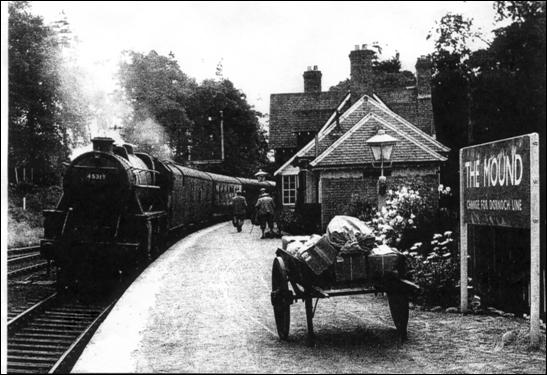
Mound
Station where Uncle Johnnie lived and worked. Out of
shot to the left was a colourful house inhabited by an Indian
named Ram (Sp. ?)
Hallowe’en
Hallowe’en was a
favourite time. Guising was not only great fun but a sure
way of getting a great bag of goodies that we did not see much
of during the year. Apples, monkey Nuts and home made
toffee were sought after. The dressing up was simple and masks
were few and far between and were either made of cardboard or of
a very brittle material like plastic that cracked easily.
Sometimes we were lucky and came upon one of those ‘gruesome’
rubber masks that fitted tightly to the face and made the wearer
unrecognisable.
Houses visited were not
only those of friends but, as at New Year, anywhere where entry
was encouraged by a light. Indeed, in general, every house
in the street and the streets around received groups of visitors
from about
On at least two
consecutive Hallowe’ens remember being taken by my mother to the
Matheson household at
Hallowe’en became quite
a different experience when we began to receive visitor
ourselves. In Thurso and then Wick in 1971 to 1975
neighbours pupils from the school visited. A particularly
large number visited in Wick as our house in
This practice of pupils
coming to the teacher’s door continued in Thurso after 1980 and
again large numbers visited
The Pictures
The cinema was held in
the YMCA Hall on
Most times we sat in the front row with our necks twisted up at
an uncomfortable angle to the screen but occasionally we managed
the second row and often sneaked into the rows further back if
the show was poorly attended. The platform was out of
bounds and anyone sneaking in there was very quickly removed by
the volunteer helpers running the show.
It was not unusual for
the show to stop abruptly due to some fault or other. Often the
breaking of the film or the loss of projector power. This
was an occasion for loud booing only matched by the noise when
we realised that the evening’s film was to be a love story and
not the western or comedy we all craved for.
Before entering the pictures we would purchase our sweets from
one of the small shops. Jack’s along opposite the Fish
Shop or Jimmy Miller’s were favourites but we did buy elsewhere
also. After the show first stop was the chip shop. If you
could get out quickly before the National Anthem at the end you
had a chance of being first in the line at the Cairnview.
For a time the chip shop was down the lane between Grants the
butchers and the Co-op drapery shop. It was here that I
remember Golspie’s first Juke Box, a small unit on the wall of
the shop and very popular it was too.
This chip shop was run
by Mr Christine, known as Abdul Ben Tattie, and then for a time
by Jim McIntosh, an engineer who was probably between
jobs. Employed there was a young man who later worked in
hotels around the village in various service capacities.
Murdo was a bit of a character and saw himself as a comedian
also. When there was queue in the shop and he was asked
how long the chips would be his favourite retort would be ‘two
or three inches’.
There were many regular favourites shown at the pictures.
Most of the big films of the day eventually reached the screen
there but there was much cheering for and western or war film
and Woody Woodpecker and the Three Stoogies made a great start
for a show. We didn’t mind the news as it usually had some
sport on and when it showed
Usually the same film
was shown at all performances though from time to time when the
evening film was not suitable for children then there would be
no matinee or an alternative programme would be shown.
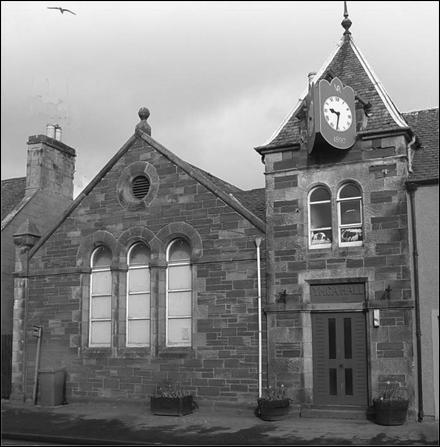
A Double Decker is Coming
The
Uncle George (Wordie)
Melville worked at Golspie station for Wordies (hence his
nickname) and he delivered goods to shops and business from the
station by horse and cart. Later one of his jobs from the
station was to open the gates at the
When George got the
message that a double decker bus or similar sized vehicle was on
its way he would speed on his small green motor bike with
protracting leg guards, which was rather more like a moped than
a Harley Davidson, to the bridge to open the gates. It was
not unknown for him to speed along
Car Numbers
Who would have thought
that a day could be passed by boys sitting on the wall on
station road taking car registrations? Cars went by so
infrequently that numbers were easily collected and there was
great excitement when more than one car came at the same
time. Everyone desperately tried to note down the numbers
and if part was missed we were able to assist one another with
the proper letters and numbers.
Every now and then we
had to count up the total to see how many numbers we had and
find out who was spending the most time by the main A9 noting
the vehicles that passed. keeping a check on the total
seemed a laborious task except for Eric Ploughman who had come
across one of those little devices for putting on bicycle wheels
to check the distance travelled. Every time a car passed
he wound it one place to keep a running total of his
registrations.
The collections had no
real purpose but then I don’t suppose train numbers kept by
some, or even stamps, have any more purpose. If a serious
crime were to be committed we could possibly be very useful
witness in tracking down the culprits!
Sledging
My only sledge was made
by my father. It was made with solid wood and had iron
strips from an old bed for runners. It was a rural green
colour and took quite a lot of pulling unlike today’s light
plastic, moulded types.
We sledged on
An alternative to
Trips to Inverness
A holiday in the late
forties and fifties, and probably before that, usually meant a
trip to
We were up very early
getting ready for the walk to the station. The train
probably came about
Sometimes we waited
outside and occasionally we got into the station office.
An interesting place with small levers and bells on peculiar
looking instruments. Every now and then a bell would ring
or a primitive telephone would call out. Usually the
message on the line was that the train had just left Brora but
it could just be that call that said that the train was
late. There was a waiting room but it was only used if the
person on duty was not known to the family and would not allow
entry to the office.
I was always intrigued
by the exchange of circular metal rings with an attached pouch
as the train came into the station. The driver held out
his hand and delivered, received or exchanged this object with
the station master or porter. It was apparently a token
which was required before the line could be declared clear and
safe for trains to proceed up or down the line.
The train puffed down
the line letting off billowing steam and not a small amount of
smoke. On curves we would hang our heads out the windows,
but not too far lest they get knock off, to look forward at the
curving carriages and engine or back to the guard’s van.
The journey seemed slow and the stops so very frequent.
The Mound and Rogart seems to come quite quickly but the wait at
Lairg for the mail from the west was always a drag and often we
had to pass the northbound train there. Carbisdale Castle was
always pointed out and the tale about its placement there
retold. The stations at Invershin and Culrain, so close
together with one on either side of the River Shin, always
puzzled until the problems for passengers having to cross the
wide river from Sutherland to Ross-Shire or vice versa to catch
the train was explained.
Ardgay always seemed
another long stop and then it was onwards to Tain with maybe a
stop at Edderton before we got there. Fearn Station, not
really at Fearn was next and then we would pull into Nigg before
one of the big stops at Invergordon. We knew we were there
when we saw the big oil tanks and my father told me about them
being wartime targets and about the Royal Navy presence there
during the war. Evanton was next on the list and the stop
at Dingwall was always a highlight. Had we time to get off
and buy a newspaper, and of course sweets, at the stand on the
station or would we be left standing when the train pulled
away? The stop there was usually longer as there might
be a train to catch or a connection with the Kyle line
might have to be made. The final stretch to
The final stage into the
station was in reverse. The train always appeared to pass
the station and then reverse in to the platform. I could
never work it out in those days but having explored the area
fully I now realise that every train had to do this.
Of course much of the stops on the line disappeared
after the Beeching Report and indeed the line to
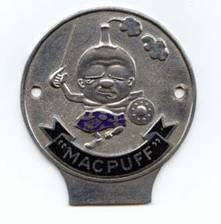
The picture above is a copy of the MacPuff
car badge and is taken from ‘The Friends of the Far North Line’
website. MacPuff was the brainchild of
Mr. Donald Shearer, at that time an art teacher at
‘Up on the Pools’
Today the football polls
still exist but most people dream of making their fortune
through the National Lottery. In the fifties and sixties
it was Littlewoods and to a lesser degree Vernons who were seen
as the saviour from the drudgery of work and poverty.
The Lannon household was not unlike any other at 4.45 on a
Saturday afternoon. As the results were read out there had
to be total silence lest my father should miss a score. A
matches list on the back page of the Saturday paper was filled
in carefully with each number coming over the crackly wireless
and then the task of check forecasts began. It never did
take very long and it was clear when the coupon was rolled up a
flung in the back of the fire that another dream had disappeared
with the unpredictable efforts of teams of eleven chasing around
a bag of wind.
Then one Saturday the
coupon stayed on the tray on Fathers lap. He checked again
and, yes, he had eight draws. A fortune awaited and on any
other Saturday it might have been. However, it was the
last week of the season and there was less than forty matches,
as opposed to over 50, on the coupon. This number of games
consequently reduced the odds on winning and so many more people
shared the jackpot. We received less than £400 and though
this was a generous sum for a working class family in 1962 it
was not the expected relief from the toils of everyday life.
The disappointment was put behind us, however, and a car was
purchased. The second hand Austin A30 was our pride and
joy despite being almost nine years old. It did provide us
with much pleasure though not a little heartache also – nine
year old cars in those days were wont to break down and needed
much care and attention.
Learning To Drive
As soon as I was
seventeen I took out my provisional driving licence and started
to work towards passing my test. There might have been
driving instructors in those days but I certainly never heard of
one let alone met one. My driving instructors were my
father and neighbour and Co-op manager Donnie Findlay.
Donnie lived across the road and he taught a number of people
around the village. His tutorship was calm and measured
while my father only had the task of sitting by me while I drove
around practicing otherwise his excitable nature would get us
into a conformation situation.
Passing my test seemed relatively easy and at the first
attempt. It was not without incident however. On the
evening before the test I had to drive up to the garage for
petrol with my father in the co-driver’s seat. He was more
tense about the whole affair than I was and he was in such a
hurry to get out of the car before I had fully stopped at the
pump he jumped out and promptly broke of the direction indicator
with rear end. For those of you who do not appreciate the
nature of the indicators in those days they were simply little
arms that shot out from the side of the car body. In Most
cases at head height but on our ‘baby’
Off Camping by Car
Our first holiday, and
in my case only camping holiday with my parents, by car was to
The
SOME
SPECIAL TIMES AND EVENTS
Christmas
Christmas was very much
looked forward to in my youngest days. Parties and
presents were few and far between. Birthdays and Christmas
were the only times up until my teenage years that I recall the
sort of social events and excitement generated by those two
occasions.
The Firemen’s Parties
The Golspie Fire Service
Christmas Parties were great fun. Games, food, Santa and a
gift were all appreciated. I was lucky enough to attend
the first and following parties. For the first party the
firemen were permitted to invite a small number of children
each, six I think. Bertie MacDonald, who lived just along
the road on
The School Christmas
Party and Concert
The party was a
wonderful occasion held in the school gym. The games were
great fun and, of course, we got dressed up for the event.
But most of all I remember the cakes - delivered from Morrison's
and large and delicious. I still see them in large baking
trays being carried round the gym by the teachers and we had the
choice of the wonderful eats.
The concert was a more
staid affair. At the time when the Primary and Secondary
departments were all one the secondary classes largely dominated
the concert. I don not remember much about the items but
do recall a play or sketch in which an attempt was made to prove
that Shakespeare's plays had, if fact, been written by Francis
Bacon. I have no idea why this play should stick in my
mind.
I only recall one
occasion when I took part in the concert. This was in a
choral speaking item. The whole class of over forty
recited 'King Midas' to great applause from what appeared to be
a large and appreciative audience. Whether it was so is
open to some doubt as a visit to the gym years later left me
with the distinct feeling that it had shrunk greatly from its
truly mammoth proportions when I was in school.
Hogmanay and The New Year
The pubs closed on Hogmanay – about 10pm I guess. They did not
open on New Years day. I think it was probably against the law
to do so at that time. My father would go to the
Caberfeidh most Saturdays and at Hogmanay. He would
usually play dominoes and drink a pint or two or more and a
whisky too. He did not come home drunk very often but
certainly merry on lots of occasions. Obviously Hogmanay
was no different and so he was already in ‘good form’ before the
New Year got underway.
Things began to change at Hogmanay and New Year firstly with the
arrival of TV. We would watch the New Year in with the White
Heather Club (Andy Stewart and others) and then the visiting
would start in earnest though there was still some midnight
`First Footing' even though the box in the corner was taking
over. When Grampian TV arrived in the area there was then the
difficult choice of The White Heather Club or Callum Kennedy!
Later again the bringing in of the New Year in groups – local
halls, local square, bonfires or street parties changed the
pattern of events. Of course transport availability also played
a part. It became possible to travel to village halls
where there might be a party. In recent years (1995 – 2005
or so) I have taken in the New Year at Dunnet Hall in
The Sutherland villages were very sociable places at New
Year. The bigger villages of Dornoch, Golspie and Brora
and, of course, Helmsdale, Bonar, Lairg and all the north and
west settlements had great celebrations to see in the New Year.
They were not dull place with nothing happening on dark winter
nights – all were vibrant communities with a great variety of
New Year activities.
The topic of Hogmanay and the New Year would need a book to
cover all the aspects and many people will have many different
experiences of those events. There will be as many ways of
welcoming in the New Year in Sutherland as there are families.
The wholesale movement of `First footers' has certainly
disappeared but the Street Party or Hall event is a good
alternative allowing large numbers of friends and new
acquaintances to welcome in other year.
The pub backdoor was a well used entry after closing time.
And indeed before as regulars took their place in the back room.
Not just at the New Year, indeed more often not at New Year, was
the back door the entry later in the evening. A great warmer for
even the Police nightshift allegedly!!
The First TV Show in Golspie and TV at Cunningham’s
I am not sure when TV
first arrived in Golspie but I remember being quite young and
taken by my father to an demonstration of TV in Lindsay
Ironmonger’s Shop. The TV was shown in the back shop in
the storage area and I recall passing through more than one room
containing animal feed stuff before reaching and upper loft
where the set was installed. I have no recollection of the
programme shown nor of who else was present though I do remember
that the audience was reasonably large and we were all impressed
by the quality of the fuzzy, grey picture on the small screen.
Later, before TV was
generally available, the youngsters of the village used to go to
Cunningham's shop and watch children’s programmes on a Saturday
afternoon. Those programmes were shown upstairs in the
store above the ironmongery and toy shop to a large audience of
children. We all sat on crude benches constructed out of
whatever material was available and watched such exciting shows
as ‘ The Lone Ranger’ and the ‘Cisco Kid’. I think there
were other series as well but those being our favourites the
others have been long forgotten.
The cost of the show was
one old penny but this did not go to the shop or Mr Cunningham
but to charity. We all had to put our penny in the charity
stocking for the children’s home at Rhu in Dumbartonshire.
As TVs became a little
more common people without a set began to find neighbours who
would let them in for a viewing session. I went with my
mother to watch at the Mathesons in
Special Football Matches at the King George Park
There were lots of well
attended football matches at King George V park in the 1950s and
1960s. Many special events with inter-county matches and
the occasional visits by Highland League clubs. In those
days the
Special Guests
Remember
going to watch a match between Golspie and some other long
forgotten opposition to find two special spectators.
Scottish top players with Hearts, and maybe internationalists,
John Cummings and Freddie Glidden were in attendance. I
got their autographs but, as was often the case, the scrap of
paper used has not stood the test of time.
Inter-County and
‘Big’ Matches
Inter-county
matches between Sutherland and
|
|
Miller Cup
Another great
occasion was the Miller Cup played for between the champions of
Sutherland and
Sutherland v
Football
supporters always look for an excuse and a reason for a
defeat. When a large crowd turned out to see Sutherland
Under 15s, including cousin Davie Melville, play against Glasgow
Boys once again my father found it difficult to give credit to
the skills of the southern invaders. He passed the comment
that it look suspiciously likely that some of those under 15
year olds were ‘already shaving’.
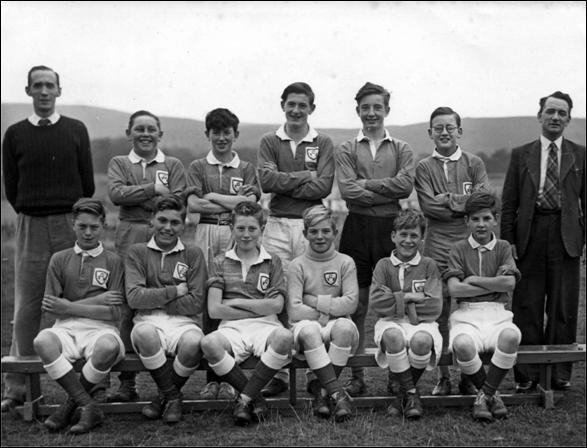
I don’t have
photograph of any of the county teams and not even one taken
when I played for the Sutherland Schools against Ross-shire –
twice in Golspie and twice at
The Butlin’s Walk
The Billy Butlin's John
O' Groat's to Lands End walk was real highlight for
villages. We wait for and clapped so many wlkers as they
made their journey south. There was a big money prize and
so a large number felt they might make 'their fortune'.
Most walked but the early competitors through Golspie were very
definitely running. I remember standing at Harold
Sinclair's shop and watching the first runner speed by.
The slower walkers seem
to be going through for days. On the Sunday one of the
walkers already tired arrived at Mass and my father taking pity
on the walker took him home to Sunday lunch. Not always a
banquet but still an occasion quite different from the meals on
others days - they could be quite frugal especially towards the
end of the week before 'pay-day'.
Barbara Moore was a
well-known walker stopping in the village though in the walk as
I remember. I recall the great publicity for this woman
and her arrival at the Stag's Head Hotel. No doubt the
date of her walking exploits will have been recorded in the
Northern Times - the 'Raggy'.
Monte Carlo
The Monte Carlo Rally in
January always interested everyone in Golspie maybe more than in
most places. The owner of the main local building business
called Alexander Sutherland and Sons was a regular
competitor. Bertie Plumb, as we knew him because his
business started as plumbing concern, was closely followed in
his exploits and on occasions was very successful. One
year he was well up with the leaders when an accident with, I
think, a cyclist in
We always wondered why
he was allowed to drive so fast in the
The race to
Northern Times - January 17,1958
Sutherland folks will be anxiously looking for
the number 177 on their television screens next week when the
The Sutherland brothers have been together in
all five Rallies in which they have competed since 1953 - there
was a gap last year when this international event was
cancelled because of the
The Sutherland brothers have certainly put the
county on the map so far as the Monte Carlo Rally is
concerned, and when they set off from Glasgow on Wednesday
morning - they leave Golspie for the south tomorrow (Saturday)
- they will take with them the county’s best wishes for a
successful accident-free drive.
The Ben Race for the Coronation and the Bonfire
I have vague memories of
the celebrations for the Coronation of Queen Elizabeth the First
of Scotland and Second of England in 1952. There was large
Bonfire set on the Golf Links close to the first golf clubhouse
that I remember. It might even have been the first
clubhouse that existed. This Clubhouse was down towards
the see and fairly close to the entrance to the course from
I don't recall who lit
the fire but I remember it being quite impressive and the winner
of the Ben Bhraggie Race got his prize there. He might
have received it first in the King George Playing fields but of
this I am also not certain.
I had particular
interest in the race as my cousin Cathel Melville was
running. He was well known in football circles having
'made it' to the
The race had many other
runners. The winner, Teddy Munro, I knew and Willie
Sutherland, better known as Horsey, was also someone I
recognized. The runners proceeded along the
Through young eyes the whole affair must have been very exciting and the quality of the competitors superb. However, maybe in this sport, and in football, nostalgia tends to make the performers of yester year son much better than those of today.
SOCIAL
AND RECREATIONAL EVENTS
The BBs and The BB Social
I very much enjoyed both
the Life Boys and the Boys Brigade meetings in the school
gymnasium. The peaked Life Boy cap in a dark navy with a
band and the badge and name on it was about the only uniform I
had. In any event I am not sure that at that time there
was any more to the uniform.
The Boys Brigade uniform
was not a lot more sophisticated. The small cap, arm band
for badges a black leather belt with BB Badge and white cross
over should to opposite waist fabric strap and pouch. They
uniform was inspected at each meeting and points award.
Activities were many and
varied at both groups but mostly games and bible study in the
younger group. On the old section bible study, various
handcrafts, games and competitions played a big part. But
most prominent were the marching routines and the physical
education activities.
The marching had to be
highly organized and proficient and was quite competitive,
especially between companies from different towns and
villages. The P. T. routines were equally rigorous and
practised until as near perfect as possible. The Box and
wooden Horse were major elements with vaulting, forward rolls
and handsprings playing a prominent part in any exhibition.
Competition with in the
Golspie Company led to inter-company. A main venue for
such competition was the B. B. Hall in Wick where Wick
competed against Golspie and Thurso Companies. There may
have been other Sutherland, and possibly Caithness Companies,
present at those events but their identities now escape me.
Football in the King George V Playing Fields
Football in Golspie in
the park at the
Just one of the versions of that famous song ‘Football in Golspie’.
When
the canvas goes out on the
And
Alec goes raking about for a ball,
And
Wullie throws open the old Welcome Hall,
It’s
a sign that there’s football in Golspie.
Then
come to the gate with your bags and the like,
You
can come on a bus, a car or a bike,
But
you canna see over the
On
the day that there’s football in Golspie.
When
coming by car as you pass through the crowd,
Just
blow on your hooter and blow it out loud,
But
you’ll see it is clear that no parkin’s allowed,
On
the day that there’s football in Golspie.
Now
here come the team with their jerseys of blue
They
are losing by now their original hue,
But
they are better than red if the Rangers are due,
On
the day that there’s football in Golspie.
There’s
Mackie, there’s Danny, there’s Hamish and Bert
There’s
Hughie and Alec and Robbies a cert,
And
a wee touch of Bobba will up your heart
On
the day that there’s football in Golspie.
There’s
lusty supporters with throats made of brass,
And
someone is shouting ‘ Hey Bobba a pass,
But
Bobba trips over a wee tuft of grass,
On
the day that there’s football in Golspie.
They’ll
come in their Bentleys, they’ll come in their Fords,
They’ll
travel from Dornoch and over the Ord, (Alternative
Line - They’ll come from the
But
they’ll meet with a shock when the Blues get
aboard, Crask and come
from the Ord)
On
the day that there’s football in Golspie.
You
can come by a boat, a bus, a car or a bike,
You
can come any way that you blooming well like,
But
you canna see over the
On
the day that there’s football in Golspie.
From a very early age my father took me to see the football in
Golspie. The crowds seemed large and excitement almost
uncontrollable. Most working men had a five and a half day
week and their main entertainment on a Saturday afternoon might
be taking in the local match.
My father’s top Scottish
team was
School Football
My greatest source of
pleasure was probably playing football for the school and
village football teams.
I played for the under
14, 15, 16 and senior school teams with some success at all age
groups. Trophies were won by all teams with the highlights
being captain of the under 16s, playing four times for the
Sutherland county team and scoring a ‘hat-trick’ for the High
School senior eleven to win the North of Scotland Cup in 1964.
My first game of football for a school team was in Brora on a
pitch that was in the field opposite where the present Brora
Rangers pitch is now and probably covered by the new Hunter's
Mill car park - new
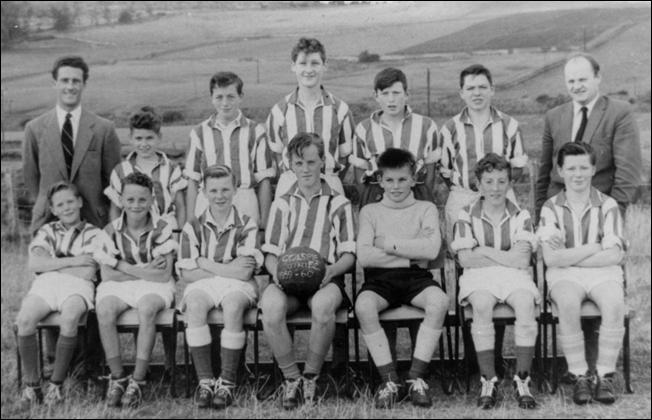
Back L-R: Norman
Brown, Ian Grant, Neil Melville, Ken Mackay, Allan Lannon,
Matthew Mackay Walter Henderson.
Front L-R: Cecil Melville, John Mackay, Ian Campbell, David Paterson, George Morrison, Sandy Morrison, Tony Rettie.
My first under 16s
county trial was played at the Golspie Sutherland Football Park
and I was not really aware of the significance of the match
until PE teacher Norrie Brown called me over to say that I had
been selected to play for Sutherland against Ross-shire at
Golspie and later in Dingwall. I was selected again the
following year after a trial at
In the upper Secondary
School I played both in Goal and at Centre forward for the
Senior team. The highlight and crowning glory was the
winning of the North of Scotland Cup in 1964. We were
successful in defeating
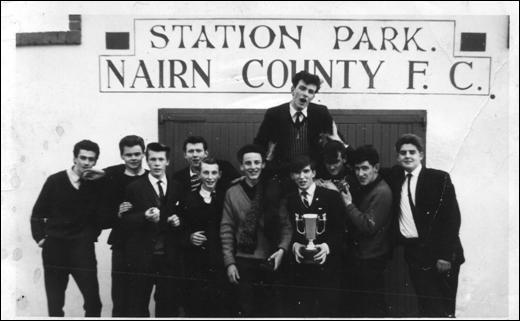
L-R; Bobby MacLeod, Arthur Fraser, Cecil Melville, Allan Lannon, Ian Taggart, John Mackay, David Cowie (on shoulders), Christopher Yuill, Alan Syme, John Robertson, Adam MacPherson
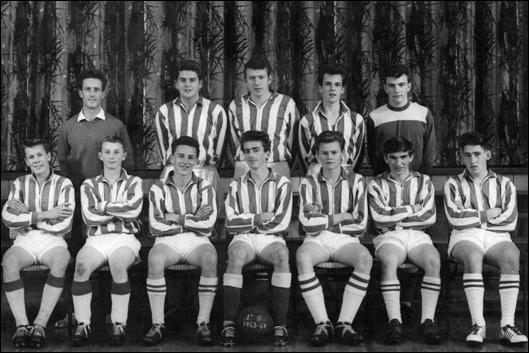
Back L-R:
Norrie Brown, Adam MacPherson, Allan Lannon, John Dalgarno,
David Cowie
Font L-R:
Cecil Melville, Ian Taggart, John Mackay, Bobby MacLeod, Arthur
Fraser, Christopher Yuill, John Robertson
Missing from the picture; Alan Syme and Walter Yuill
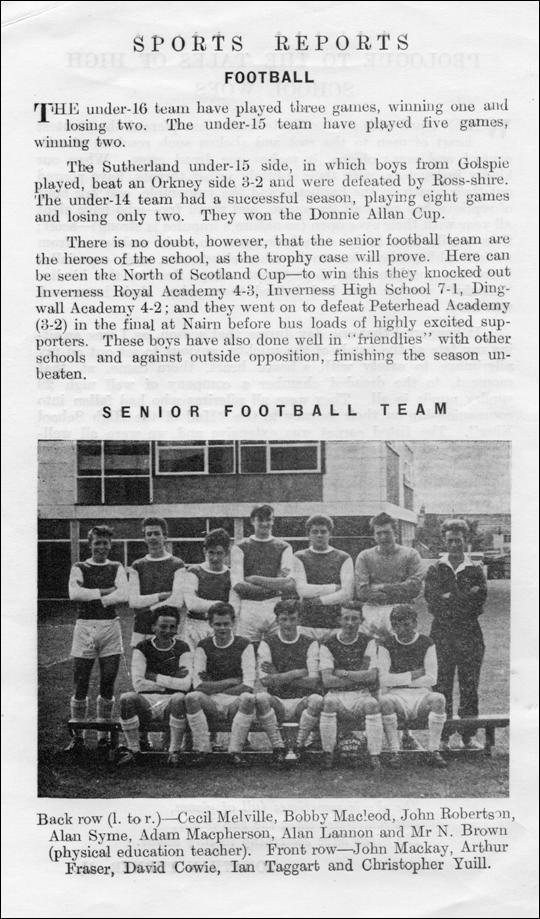
This page
from the school magazine tells about the senior team’s success
in 1963-64 season. I am pictured in gals but only played
in that position in the first game against Thurso. In all
the other matches I played at center forward.
Senior Football
From time to time I was
lucky enough to get a game for Golspie Sutherland. I
either got to substitute for Billy Murray, a fine goalkeeper who
held down first spot when I was a teenager, or at centre
forward. I had some regular matches at centre after my
success in the senior school team. However, Saturday work
in the Co-op Shop and then the move to Thurso curtailed my
chance of a long term place in Golspie’s senior team. This,
however, did not finish my footballing career as I went on to
play for Dounreay Athletic, Wick Groats, Wick Thistle, Wick
Rovers and Keiss. In addition, I played for, and gained my
colours in football, while a student in
WORLD
OF WORK
Tattie Howking (sp. ?)
The following year and possibly two years I picked the Tatties
at Kirkton Farm in the Tattie Holidays in October. Again
the work was back-breaking and I cannot recall how much was
earned but at the end of the time I suppose I thought it
worthwhile. Transport
to and from Kirkton was in sheep lorry which picked us up
outside Cunningham’s shop.
The Co-op
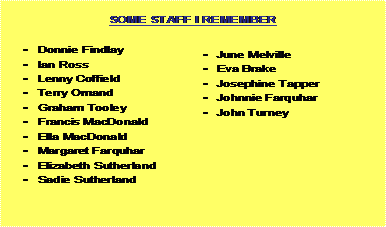
Just some
of the staff I remember and there were others and apologies to
them for omitting them from the list. There was also a
staff working above the grocery shop in the area office
for/with Mr Sutherland who lived above the co-op drapery
department. He had two sons whom I later met at
Dounreay. Both died at a relatively young age.
I started working in the Co-op Shop in Golspie on a snowy first
week in January in 1959. I am not sure that I was looking
for a job though it must be said that to get a post as a message
boy was desirable bringing with it the 30/- a week payment.
I only once had help
loading up the bike and it must have been during the first week
of my duties. I had to hold the bike upright and with
weight on the seat keep it steady while Duncan Halfpenny and
Ivor Sutherland, two older teenage employees loaded my vehicle
so high that I would not be able to see over the top. This
problem was purely academic. As soon as they had finished
and asked me to push the bike off the stand it upended with the
resulted that all of the grocery boxes landed on the back shop
floor with the bike on top. A fearful mess of mixed
shopping and not just a few broken bottles. Especially the
Soda Siphons with gaseous liquid pouring forth.
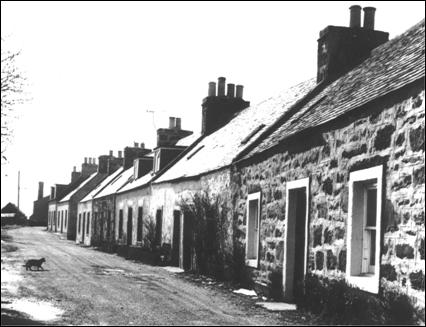
There were lots of
customers in
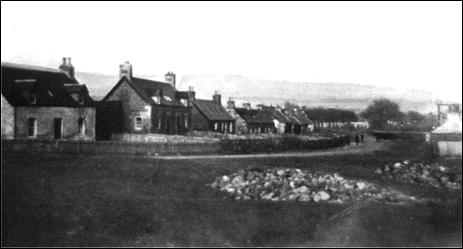
Church
Street, and Sutherland Road running parallel behind it, were
also busy roads for me.
My Co-op duties included some welcome overtime in the form of
domestic activities on the Wednesday afternoon and early each
morning. On the early closing day I went to the shop after
school and washed the floor with mop, bucket and detergent for
an extra 5/- and I gained a further 5/- for delivering morning
rolls to the girls’ hostel, MacLeod House, each morning.
The Golspie Co-op Shop seemed very large to me at that
time. It probably was when compared to other local shops
but when I look at it now with the ‘large’ back store included
in the shop floor area I realise that it was more likely the
view we have of places remembered as being bigger than they
really were.
The exceptions to the service over the counter were the items in
the few display stands that backed up to the shop counter on one
side of the floor space. The two I recall were the Swiss
Knorr Packet Soup stand and the biscuit box stand. The
biscuit box stand had the boxes facing outwards at an angle of
about 45 degrees and with the lids removed but with a glass
cover protecting the contents. The biscuits were all, of
course, loose and many got broken. Those were sold at a
cheaper rate and often to children heading for school as ‘play
pieces’.
Merchandise behind and below the counters was set out on shelves
and in suitable sections according to type and brand.
Those shelves had to be filled up at quiet times and often boxes
were brought from the ‘back shop’ during busy period and left on
the floor close to where they eventually be stacked. Some
items which were dangerous or more valuable were kept in drawers
below the shop serving counter. There was a designated
area for bacon, hams, meats and cheeses in the back left hand
corner of the front shop. On the counter opposite this
marble topped surface was a large bacon and meat slicer which
was worked by hand using a large wheel and handle. A
dangerous piece of equipment which I had to clean and sharpen
from time to time. Cleaning was done with cloths held
against the blade and sharpening with a set of abrasive rollers
that pulled down onto the top of the very large circular blade.
The back shop, which appeared to me at that time, to be quite
large was like an Aladdin’s Cave but stocked with every
foodstuff, toiletry and saleable item imaginable. The
contents were mostly delivered by lorry from
Some materials, particularly cereals and on rare occasions
flour, were delivered in large hessian sacks. Most about
one hundred weight but varying in size depending on
content. Recall very large bags of maize taken if for
animal feeding in incredibly large cloth bags that were very
floppy and difficult to carry. We also got corn for
feeding hens and this too had to be weighed out into stone
weight bags.
Most of those goods had
to be weighted in the shop for selling when customers requested
or weighed in advance. Also weighed in advance when time
permitted were potatoes. They came in bulk and were stored
in a large wooden hopper with an access shoot at the bottom from
which the potatoes were shovelled into half stone and stone
brown paper bags and weighed on a balance type scales.
Fruit on sale was a very
limited selection. Mostly bananas, apples, pears and
oranges though there were sometimes melons. Bananas came
into the shop in long wooden boxes like small coffins with a
hinged lid. They were Fyffes bananas and a pretty good
chew as I cycled round the village. We usually got bags of
blackening bananas home on a Saturday evening as they would not
sell by Monday due to their condition. McIntosh Red apples were
also a favourite coming into the shop in large cardboard boxes
in layers and sitting in egg box like hollows in the
trays.
Bacon and some cooked
meats were stored in a wooden cupboard with a gauze on the
doors. The was supposed to keep the meat cold and keep out
insects though I from time to time had the job of picking the
white maggots out of the rolled bacon.
Lemonade was delivered by Hendry’s of Wick who certainly had a
contract with the co-op and may have been actually part of the
co-operative establishment. Initially a fairly limited
range of flavours was available but the company gradually
introduced new recipes with one popular one with the staff being
raspberry. Fizzy raspberry not being a drink I would now
favour! This lemonade was stacked just inside the
side store of the back shop with the crates on their side for
easy access to whatever flavour was required. This
resulted in some bottles leaking and encouraged some of us staff
members to find extra bottles of our chosen drink developing
rather large leaks. ‘Leakers’ as they were simply known
were returned to Hendry’s at the next delivery for credit.
Coal and Paraffin was
stored in a shed behind the shop and more or less in
Sutherland’s Builders yard. The long shed also
accommodated two garages. The Coal came in 28 lb paper
sacks and proved very popular with older people living along and
quite a lot had to be delivered.
The paraffin was held in a very large tank on supports about
three feet of the floor. The liquid was taken off via a
tap set in the base of the storage tank. The paraffin
should have been taken firstly into one of the half or full
gallon measuring cans before being funneled into the customer’s
fuel can. We, meaning younger and part-time staff, often
tried to speed up the process by filling the fuel can directly
from the tap. We were careful not to give short measure as
this would bring the customer back and sometimes the fuel can
would slip, especially if it was a five gallon one, and we would
be covered in nasty smelling fuel. From time to time the
shop manager caught us out as he would intercept a filled fuel
can and weigh it to determine how much paraffin we had put in
it.
Skinning the Cheese
When preparing a very
large cheddar type cheese for sale it was necessary to remove
the outer gauze covering and the wax protection from the
cheese. The Cheese was large and had to be manhandled into
a Hessian sack which had previously been soaked in water.
Any sack would do and they were mostly once which potatoes had
been delivered ion and so were not particularly clean. The
cheese was left to soak overnight until the gauze and the wax
was thoroughly sodden and soft. It took some effort to
remove the gauze covering but with much tugging it eventually
came away with the wax. Some tidying up had to do around
the cheese and then it was cut into more manageable size pieces
for storage or placing on the marble top in the front shop.
Stock Taking
At Stock Taking time
there was lot of work to do and overtime during the weekend or
during that week. Preparation for Stock Taking involved
ensuring that shelves were not stacked fully and that as many
boxes of goods in the back shop were left full and easily
accessible. Stock was boosted by cutting apart ‘multipack’
items. In those days ‘multipack’ simply meant something
like bars of soap bundled in three with a paper wrapper.
One job the part time staff had to do at this time was cut off
the band wrapper and free the three bars of soap which were then
unidentifiable as anything other than three bars of normal
soap. Since this increased the soap stock by one third,
one bar being free in the special offer, the value of the shop
stock was consequently increased against the delivered
stock. This happened with enough items to keep the shop
stock in a comfort zone as far as the area management were
concerned. Another way stock was adjusted was by the
writing off of perishable items. Such items would be fruit
and bakery produce and the actual amount dumped would be
inflated by just enough to be seen as reasonable and again
ensuring stock level was more than maintained. Of course, it is
not now permitted to break up multiple packs though no doubt it
does happen with some products.
Work meant money and my first personal savings were with the
Post Office.
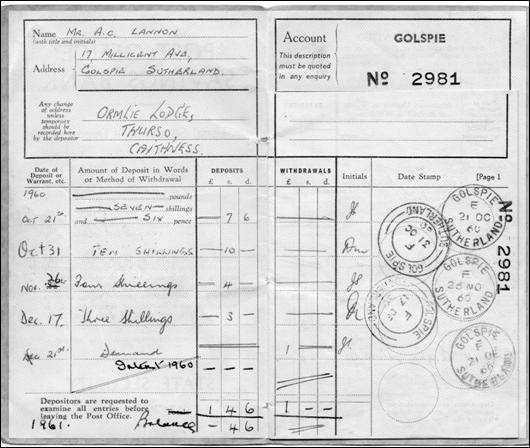
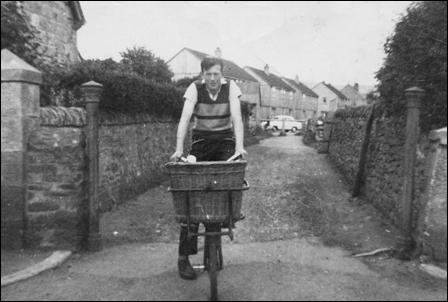
Yours
truly at the end of the lane joining the end of
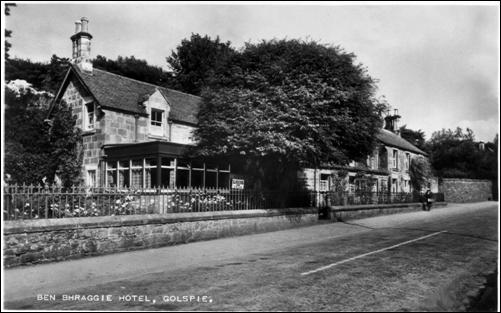
Mrs Joiner
was the owner of the Ben Bhraggie Hotel when I had to deliver
the hotel order to the back door in the cobbled
courtyard. There was a quite large water well in one
wall of the courtyard.
Looking for a Job
In the early 1960s
youngsters did not have as much worry about future employment as
they have now. Getting a job was not all that difficult
though the first choice might not always be obtained. I
knew that I could enter the Co-op Shop and work there with the
prospect of promotion. Managers tended to male and
relatively young. Provided one was willing to move around
and go to small shops in out of the way places then here was an
occupation that was secure and free from the rigours of the
weather.
Boys going into apprenticeships seemed to get a five year
training in some trade or other. Some jobs, such joinery,
were more sought after than others but the building industry was
still labour intensive and so lots of mason, plumbers, painters,
etc. were always required.
While the shop work had served a very useful purpose I did not
really want a job that tied me to a Saturday indoors. My
sporting instincts lead me in the direction of a week end off
job. If I had to work a Saturday, or even a Sunday, I
expected overtime and for it to be my choice. My father
had, of course, had to work a five and a half day week but at
least he had Saturday afternoon off.
Wales and the Robertson Research Compan
On preparing to leave
school the top priority was to find a ‘good’ job. In 1963
there was a great interest in finding mineral resources around
the country and Sutherland was particularly targeted by the
Robertson Research Company. They advertised the fact that
they wanted to recruit a local person to be trained in their
Welsh laboratory for return to Sutherland as part of this
work. I applied for this training and was interviewed in
Dornoch. I seem to recall that David Mackay and one of the
Sadler brothers were also interviewed. Studying Geography,
while the other two had been studying History, seemed to give me
an advantage and I was offered the post.
Rolls Royce and then to Dounreay
When leaving school the
first priority is to get a job and I was interviewed by A1
Welders in Inverness, the Robertson Research Company for
training in Wales, the UKAEA at Dounreay and Rolls Royce in
It was necessary for me
to find accommodation in the area and by telephone I obtained an
address and telephone number to contact from Rolls Royce.
In those days you often had to go through operators and we had
to make calls from the public telephone kiosk. Either the
box at the Post Office or the one on
John and I had a look
around the local area and on a couple of occasions we went to
football matches. On one trip to Motherwell he forgot where he
parked the car and it took us some time to find our transport
back. There was also a visit to
I travelled to Strathaven with my mother, father, Ian and James
in a very small Baby Austin and this included carrying, on a
roof rack, my luggage and tent which they used for a few days
after I was placed in my B & B. They actually camped
in a field close to Kirkland Park Avenue and I think it was
probably fixed up with the farmer by the Rollo family.
Our journey to Glasgow
was uneventful other than getting caught up in a protestant
order march in the city center and really knowing nothing about
the parade and puzzled as to why so many people were marching
with peculiar costumes and aprons, playing small pipes and rums
and being either cheered or booed from different parts of the
watching crowd.
At Rolls Royce I was to
train as a Technical Apprentice with a view to going into the
drawing office or design department. The initial training
was to be in the Training Centre with the Trades
Apprentices. They were a very city wise and tough group
ready to take advantage of every opportunity for profit.
They took it in turns to leave the center to buy jam rolls and
tea in billycans for the Technical Apprentices and they always
had a good markup.
I remember the first question I received for the other lads when
I entered the center related to my place of education.
This was a clear attempt to elicit my religious leaning but my
answer of Golspie perplexed them more than a little. When
I said that Golspie was in Sutherland I recall one chap asking
me if Sutherland was a big ‘toon’. Once religious
affiliations were sorted out then the side of the workshop on
which ones bench was located became a matter of allocation
according to those affiliations.
The work in the center was monotonous in the extreme. I
recall the first exercise was to remove two large dents from a
very flat piece of metal using a file and a scrapper. The
instructor appeared to thump my piece of metal with great glee
with his hammer before telling me to file the marks out.
The final flat piece of metal had to be correct to a very high
tolerance level and this was checked by rubbing the flat face on
a very flat metal table to which a purple dye had been
applied. The high parts on the surface showed up purple
and it was back to the bench to scrape off the high marks.
This succeeded in leaving different high marks! The first
task must have taken close to three weeks. Later tasks
included two sets of steps that must fit together perfectly, a
dovetail joint in metal and a male and female locking
joint. All were very difficult to achieve though none as
time consuming as the first exercise.
Part of the three months I was with Rolls Royce was spent at
One of my first wage packets came to me at
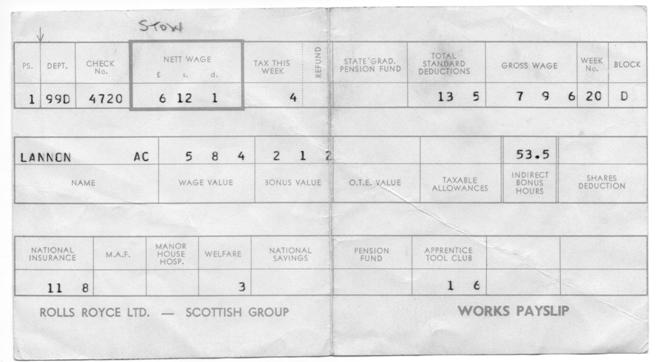
In all working in the
West of Scotland was a distinct experience and though not always
pleasurable there were good times and every type of experience
prepares one better for the next stage of life.
While in Strathaven I
awaited a call from the UKAEA at Dounreay. Eventually the
offer of a job arrived and a security representative from
And then four years on
there was